



















































 VENETIAN PRINCESS
RALEIGH’S VILLAGE DISTRICT
VENETIAN PRINCESS
RALEIGH’S VILLAGE DISTRICT


























































 VENETIAN PRINCESS
RALEIGH’S VILLAGE DISTRICT
VENETIAN PRINCESS
RALEIGH’S VILLAGE DISTRICT





Here’s to the land of the long leaf pine, The summer land where the sun doth shine, Where the weak grow strong, and the strong grow great, Here’s to “Down Home,” the Old North State!
— From “The Old North State” by Leonora
MartinAs the season heats up, bring the cool colors of Carolina inside. Visit us today to experience more than 30,000 square feet of unique furniture, accessories, hand-knotted rugs, and luxurious upholstery. Cheers!
Leather Wingback Chairs & Ottomans by Lillian August for Hickory White, Dining Table by Theodore Alexander, Jar by Scalamandre Maison by Port 68, Gold Tray by Revelation, Art by Wendover Art, Hand-knotted Rug from Pakistan


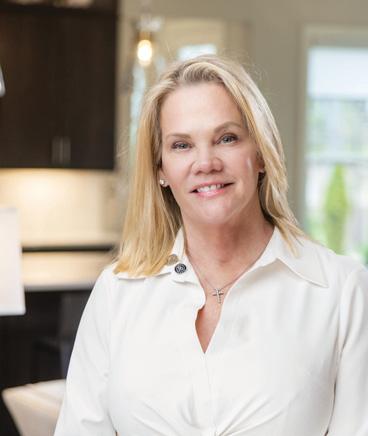













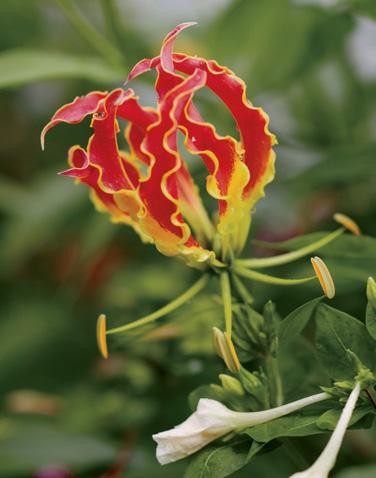
53 this i know for sure by Jaki Shelton Green illustration by Stephen Hayes
54 Smoke & Fire
Ed Mitchell’s take on barbeque introduction by Ayn-Monique Klahre photography by Eamon Queeney and Baxter Miller
62 Tropical Transformation
A Cary garden with bold color by Hannah Ross photography by Liz Condo
70 Go Fish!
The lure of Big Rock by Ayn-Monique Klahre photography by Dylan Ray
78 It’s a Colorful Life
In the studio with artist, teacher and arts advocate Bob Rankin by Katie Pate photography by Joshua Steadman

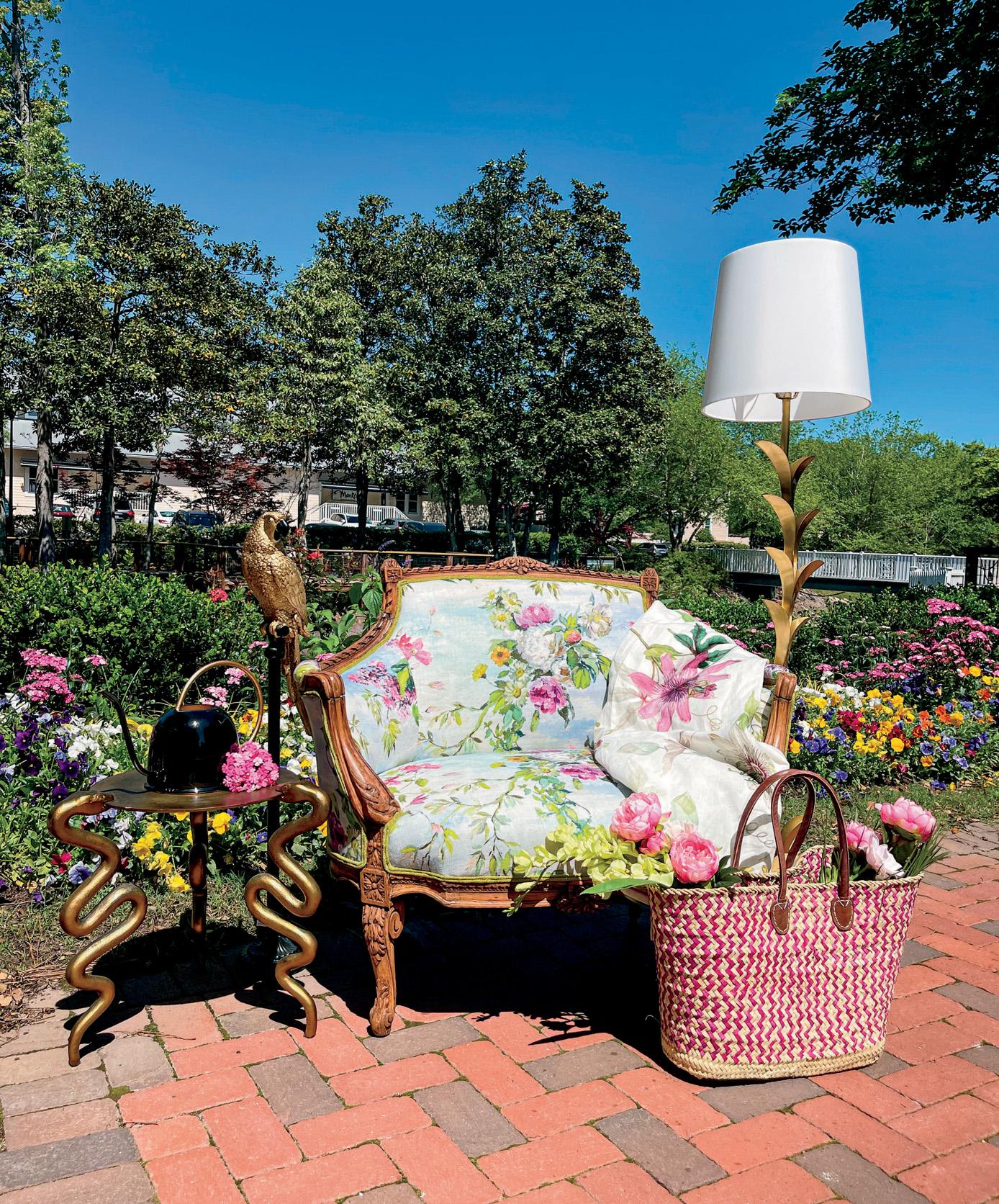












The other day, I was having a conversation with a girlfriend about how our dads are different as grandfathers than they were as fathers. The men we remember from growing up were strict disciplinarians, intimidators of any friends who came over for the first time. (Some of my high school friends still refer to my dad as “Big Frank,” even though I’m pretty sure he’s average-sized.) As fathers, these men meted out the serious punishments and stayed up to make sure we were in by curfew — not one minute later.
But as grandfathers, they’ve definitely gotten soft.
When I was on maternity leave with my first daughter, my dad came up to spend a week with me after Josh went back to work after his measly two weeks off. This was in the early weeks of parenting, when we were still trying to figure everything out. I needed help!
And thankfully, as a grandfather, my dad had infinite patience for accomplishing whatever task I asked. If I asked him to take my daughter for a walk, he’d be out with the stroller for hours (and I would finally, maybe, get a nap and a shower). If I asked him to nap the baby, he’d get her in a football hold (we called it “sleeping tiger”) and plant himself on the couch. Once she fell asleep, he’d nap, too, for as long as it took. When our second daughter came along, he was happy to repeat the process.
As my girls have gotten older, it’s fun to find them chatting over shared interests. In our weekly FaceTime calls, we’ll get tours of the garden or the latest home project from my parents, and in return they get surprisingly detailed accounts of the school day or their latest theater production. When my parents come to visit, they’re likely to get suckered into ice cream before dinner or some other little treat. And I see it with my two young nephews — I don’t remember getting to eat at Shake Shack nearly so often, and only my dad can match his 4-year-old grandson, my nephew, in his stamina for talking about airplanes. (It helps that Dad’s a retired pilot.)
Right now Josh is in full “dad” mode — always in the position of reminding the kids about rules and to-dos and the importance of brushing one’s teeth before bed. But I’ll be interested to see if he gets to take it easy with the next generation. NO RUSH.
To all the dads, granddads and father figures out there, happy Father’s Day this month!
 Ayn-Monique Klahre Editor
Ayn-Monique Klahre Editor






KOKA BOOTH AMPHITHEATRE, CARY
The Music of Whitney Houston SAT, JUNE 3 | 8PM
Fire & Rain:
Songs of the ’70s FRI, JUNE 9 | 8PM
Concert Sponsors: Galloway Ridge at Fearrington, RGA Investments
All Beethoven SAT, JUNE 10 | 8PM
Concert Sponsor: Residence Inn Raleigh Downtown A Little Night Music FRI, JUNE 16 | 8PM

Classics Under the Stars
SAT, JUNE 17 | 8PM
Harry Potter vs. Star Wars
SAT, JUNE 24 | 8PM
Concert Sponsor: Triangle Community Foundation
Cirque Cinema SAT, JULY 1 | 8PM
Tango Caliente SAT, JULY 8 | 8PM

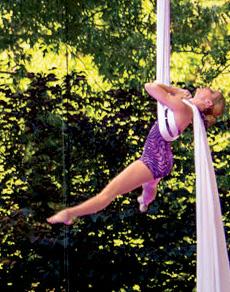
The Catalinas SUN, JULY 16 | 8PM The Symphony will not
JUNE 2023
EDITORIAL
Editor
AYN-MONIQUE KLAHRE ayn-monique@waltermagazine.com
Creative Director LAURA PETRIDES WALL laura@waltermagazine.com
Associate Editor
ADDIE LADNER addie@waltermagazine.com
Contributing Writers
Catherine Currin, Jim Dodson, Mike Dunn, Jaki Shelton Green, David Menconi, Ed Mitchell, Katie Pate, Hannah Ross, Liza Roberts, Rachel Simon, Katherine Snow Smith, Billy Warden
Contributing Poetry Editor Jaki Shelton Green
Contributing Copy Editor Finn Cohen
Contributing Photographers
Liz Condo, Terrence Jones, Baxter Miller, Eamon Queeney, Matt Ramey, Dylan Ray, Bryan Regan, Joshua Steadman
Contributing Illustrators Stephen Hayes, Gerry O’Neill
Interns
Nakya Carter, Emma Deal, Jamaul Moore

Publisher DAVID WORONOFF
Advertising Sales Manager JULIE NICKENS julie@waltermagazine.com
Senior Account Executive & Operations CRISTINA HURLEY cristina@waltermagazine.com
Events Manager KAIT GORMAN kait@waltermagazine.com
Finance STEVE ANDERSON 910-693-2497
Distribution JACK BURTON
Inquiries? WALTER OFFICE 984-286-0928
Address all correspondence to: WALTER magazine, 421 Fayetteville Street, Suite 104 Raleigh, N.C. 27601
WALTER is available by paid subscriptions for $25 a year in the United States, as well as select rack and advertiser locations throughout the Triangle. Subscribe online at waltermagazine.com/subscribe
For customer service inquiries, please email us at customerservice@waltermagazine.com or call 818-286-3118.
WALTER does not accept unsolicited manuscripts.
Please contact Ayn-Monique Klahre at ayn-monique@waltermagazine.com for freelance guidelines.
Owners
JACK ANDREWS, FRANK DANIELS III, LEE DIRKS, DAVID WORONOFF In memoriam FRANK DANIELS JR.
© WALTER magazine. All rights reserved. No part of this publication may be reproduced in any form without the express written consent of the copyright owner. Published 12 times a year by The Pilot LLC.





Our
Our

Terrence Jones is a Raleigh-based photographer who found his passion for photography as a shy kid with dyslexia. With a decade of experience as a lead photographer for a regional magazine, Jones now focuses on capturing portrait moments for business, healthcare and fitness clients. His dynamic imagery has been praised by former clients, including Duke University and Agri-Waste Technology, while small business owners appreciate his ability to tell their stories visually. In his free time, Jones enjoys mountain biking in North Carolina. “It was great meeting and photographing TikTok and YouTuber MajorKeyLife. He and his uncle are a hoot!”

BILLY WARDEN / WRITER

Liz Condo is a photographer of people and places. She has spent her varied career exploring the ways an image can open our eyes to the beauty all around us. A gardening enthusiast, she loves how the simple act of caring for plants can deepen our connection to the natural world and provide much-needed habitat for wildlife. “Every part of Berry and Dick Hayter’s garden was thoughtfully designed. It was fascinating to hear why Berry chose the plants she did, how they reminded her of places she had lived before. The whole garden was bursting with life and color, and felt a world away from North Carolina.”

KATIE PATE / WRITER
Same-Day CEREC Crowns Suresmile Clear Aligner Orthodontics


www.drgregweaver.com
Billy Warden has taken on big projects as a producer for E! Entertainment Networks, the co-founder of marketing agency GBW and writer for publications from The Los Angeles Times to Our State. But his first major endeavors came as part of his dad’s work detail on elaborate home and yard enhancements. “D.I.Y. projects often come down to creativity and improvising,” he says. “Get comfortable with those things, and life is a whole lot more fun.”
A Raleigh native and professional writer, Katie Pate has been part of the local arts and music community since adolescence. Pate graduated from Appalachian State University, is a freelance marketing consultant and serves on the Raleigh Historic Development Commission. You can find them writing poems at Morning Times, biking the Raleigh Greenway or watching live music. “Everyone I interviewed about Bob Rankin was emphatic about what an honor it is to be part of telling his story. After witnessing Bob’s talent and compassion firsthand, I can only agree.”
We got so many compliments on our May cover, featuring artist Marriott Little.
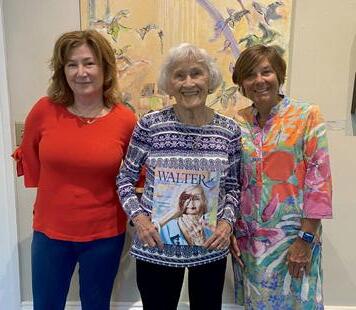
“Great cover image of a great Raleigh artist and person!” — Leslie Pruneau
“That cover is fire! My first thought was, wow she’s gorgeous!” — Susanna Klingenberg
“Marriott is an inspiration to me and so many other artists! Not to mention a lovely person.” — Creecy Andrews
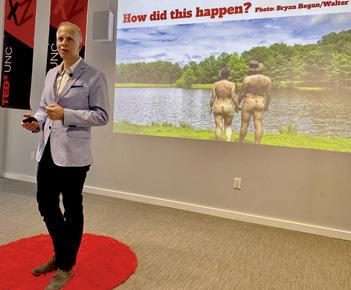
Contributor Billy Warden gave a TEDx Talk at UNC-Chapel Hill about his adventures writing for WALTER, including learning about naturalism last summer.


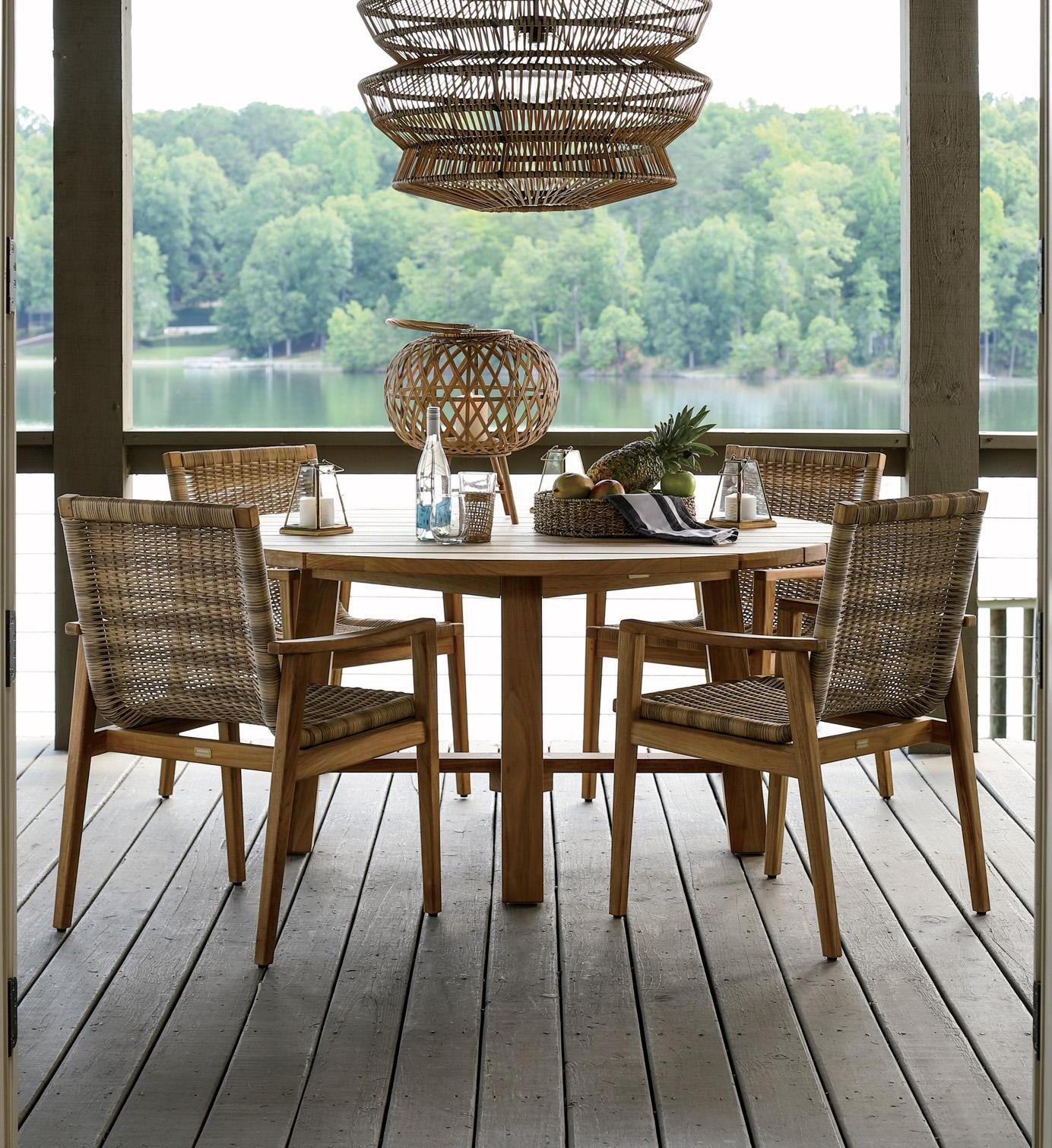
Summer is here! This month brings jazz dinners, outdoor concerts, Juneteenth celebrations and festivals galore.
by ADDIE LADNER


June 17 - 19 | Various times
Four years after Victoria Scott-Miller started the pop-up bookstore Liberation Station, she’s opening her first brick-and-mortar location. It will be the first Black-owned children’s bookstore in Raleigh, with more than 1,000 titles that represent Black characters, writers and illustrators. “This store is beyond our ancestors’ wildest dreams, one that acknowledges our place in North Carolina history while unearthing a diverse spectrum of affirming Black images from every fabric of our life,” says Scott-Miller. The grand opening will be a weekendlong celebration leading up to Juneteenth. On Saturday, notable children’s book authors, including New York Times bestselling author Derrick Barnes and awardwinning author Tameka Fryer Brown, will be at Liberation Station for book signings. On Sunday, the bookstore will host White Glove Day, where guests can interact with historical documents including letters written by Frederick Douglass and signed, first-edition books by Octavia Butler, Langston Hughes and bell hooks. On Monday, there will be a walk from the state capitol to the bookstore led by a group of Black equestrians, followed by a book signing by Caitlin Gooch, the founder of nonprofit Saddle Up and Read, which works to help children achieve literary success through equine activities. Free admission; 208 Fayetteville Street, Suite 201; liberationstationbookstore.com
June 1 - 18 | Various times
June is busy at North Carolina State University, where its annual TheatreFest will host a cluster of shows celebrating all aspects of live theater. In addition to watching productions of various genres, guests can participate in Q&As with playwrights and enjoy a festival showcasing the area’s various theater companies. The first play is Jeffery Hatcher’s Holmes and Watson, a thrilling mystery about the presumed but questionable death of famed detective Sherlock Holmes. Also enjoy a comedic musical about two guys writing a musical, called [title of show]. The festival itself is on June 17, showcasing the Triangle’s many theater companies, as well as QuickSCRIPTS, an evening of four short plays written, cast and produced in just 72 hours. Various prices; Talley Student Union, Suite 2110, 2610 Cates Avenue; theatre.arts.ncsu.edu

June 1 | 7 p.m.
Dead & Company was formed in 2015, 20 years after legendary Grateful Dead guitarist and singer-songwriter Jerry Garcia passed away, as a way to honor his legacy. Since its inception, Grateful Dead alumni Bob Weir, Mickey Hart and Bill Kreutzmann have been joined
All information is accurate as of press time, but please check waltermagazine.com and the event websites for the latest updates




by a host of notable musicians each summer, including Allman Brothers Band bassist Oteil Burbidge and John Mayer. The group will stop at the Coastal Credit Union Music Park at Walnut Creek as part of their last tour. From $100; 3801 Rock Quarry Road; deadandcompany.com


June 3 | 11 a.m. - 9 p.m.
Celebrate the vibrant cultures that make up Raleigh at the International Food Festival. More than 60 vendors will be serving dishes with roots in countries from Scotland to El Salvador to Syria. The festival will also include live performances of traditional dancing from various countries as well as a 1970s and ‘80s outdoor dance party and contest. The City of Raleigh Museum will offer special programming in conjunction with the event, including puppet shows, folk stories, face painting and story time. Free; Fayetteville Street; ncvibes.com
June 3 | 10 a.m. - 3 p.m.
Enjoy Mother Nature’s gifts in all forms at Fred Fletcher Park. This whimsical celebration of fairy tales, food and flowers is hosted by the local children’s event planning group Paper & Stars Studio in conjunction with the City of Raleigh. Free admission; 820 Clay Street; raleighnc.gov
Tuesdays | 5 - 8 p.m.
Bring the family to Brookside Bodega on Tuesdays for live, local music on the patio. Americana act Sentimental Johnny from Hillsborough plays on
June 1 - 11 | Various times

NOTED


Theatre Raleigh will present the world premiere of North Carolina playwright Allan Maule’s The Weight of Everything We Know, a romantic comedy about science, writing and coping with elements beyond our control. The story starts when Lucia, an astrophysicist, and Darrow, a writer, are set up on a date. As their relationship progresses, there’s a major upheaval in the scientific world: A decision is made to change the way a kilogram is measured. “When I read about the kilogram changing mass, I knew there was a great dramatic premise there. This breakthrough would upend everything for scientists, but leave others puzzled. So what if this all happened while a scientist and a non-science type were falling in love?” says Maule. From $30. 6638 Old Wake Forest Road; theatreraleigh.com
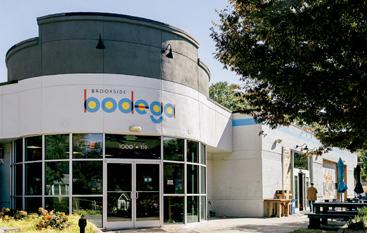
June 6, and DJ Jay Tay will spin tunes on June 13. Monica Kennedy will sing cover favorites on June 20, as will J.A.K. Acoustic Covers on June 27. Tuesdays are also $2 off draft beers to wash down the Bodega Nachos or Bodega Burger on an early summer evening outside. Free to listen; 1000 Brookside Drive; brooksidebodega.com
June 10 | 11 a.m. - 4 p.m.
Food trucks will line Academy Street to celebrate a Southern staple at the Pimento Cheese Festival. Enjoy live music at the Downtown Park, grab a

drink from local breweries and taste some inventive pimento cheese dishes. Gussy’s Greek, Ultimate Egg Rolls and Big Mikes BBQ are a few of the many participating local food trucks that will offer both their regular menus and new, on-theme specials (see: pimentocheese ice cream). You can even test your skills in the pimento-cheese sculpting contest. Free; 319 S. Academy Street, Cary; carync.gov
DINNER AND JAZZ AT HUMMINGBIRD
June 14 & 28 | 7 - 10 p.m.
Enjoy a pop-up speakeasy and jazz club
June 23 | 8:30 - 11 p.m.
The amphitheater of the North Carolina Museum of Art is a favorite spot for an outdoor film and picnic. This year, the museum’s summer movie lineup is centered around the theme Esse Quam Videri, the North Carolina State motto, which translates to “to be rather than to seem.” One film that reflects the idea is the animated children’s movie Turning Red. It’s about a young teenager who suddenly starts turning into an enormous red panda when she’s emotional — much to her inconvenience at school and at home. This lively, heart-warming film explores Chinese traditions, the trials of coming of age and our sometimes complicated relationships with family. Registration required and picnic blankets, chairs and food welcome. Free for members, $7 for nonmembers, 2110 Blue Ridge Road; ncartmuseum.org

POTTER VS. STAR WARS
June 24 | 8 p.m.
Hear the scores from two fantasy blockbusters, Star Wars and Harry Potter, at the North Carolina Symphony’s SummerFest. Led by conductor Lawrence Loh, the evening of wands versus lightsabers takes place at Koka Booth Amphitheatre in Cary. Keep an eye out for musicians disguised as Professor Snape or Imperial Stormtroopers, and you’re encouraged to dress in your favorite wizarding or futuristic wardrobe. From $35; 8003 Regency Parkway, Cary; ncsymphony.org
PETER FRAMPTON
June 24 | 8 p.m.
I want you, to show me the way to Red Hat Amphitheater to hear British mu-





DRI has provided state-of-the-art imaging services for nearly 40 years. Now in the Raleigh area, we hope you will let us care for you and your family. We offer immediate appointments and exceptional care in a beautiful, comfortable environment.
• CT Scan
• X-Ray
• MRI
• Ultrasound
• Cardiac Scoring
• Lung Screening
• Virtual Colonoscopy
Wakefield Professional Plaza 11009 Ingleside Place Suite #103, Raleigh 919.521.8311
Hours: Monday–Friday, 8am to 5pm
DR I healthgroup.com
sician and Rock & Roll Hall of Famer Peter Frampton on his North American “Never Say Never” tour. A hitmaker since the 1960s, Frampton has a star on Hollywood’s Walk of Fame, a handful of Grammy nods and a win for Best Pop Instrumental Album for Fingerprints (2006). From $30; 500 S. McDowell Street; redhatamphitheater.com
June 24 | 11 a.m. - 6 p.m.
Themed “Love 365,” OUT! Raleigh Pride Festival is the Triangle’s yearly come-one-come-all, family-friendly celebration of the LGTBQIA+ community. The festival, which benefits the LGBT Center of Raleigh, will include more than 100 vendors, music, speakers, a KidsZone on Fayetteville Street and — new this year! — Raleigh’s first Pride Parade. Free admission; downtown Raleigh; outraleighpride.com
AFTER 5 June 21 | 5 - 8 p.m. NOTED
Presented by the Downtown Raleigh Alliance, Live After 5 is a free concert series in downtown’s One City Plaza. This block-party-style celebration will feature a lineup of cover bands playing music by acts from the 1980s and 90s. This month, Live After 5 will showcase Hard Tuck, a cover band made up by musicians Kate Rhudy, Joseph Terrell and Chessa Rich, with deejay King Akira. The event will also feature Wye Hill Kitchen & Brewing’s signature seltzer “The Sweet Life,” plus goodies from other local vendors. Chairs and picnic blankets are welcome. Free admission; 443 Fayetteville Street; downtownraleigh.org










honor of Pride Month, a ROYGBV selection of beverages
by CATHERINE CURRIN photography by BRYAN REGANSince the late 1970s, the rainbow flag has been used to symbolize the diversity of human sexuality — and this month, you can expect to see that spectrum of colors popping up in more places than usual: from Trophy’s Run for Love 5K race to the Durham Bulls’ annual Pride Night, to specialty items at stores and on menus
and Raleigh’s first Pride Parade this year.
“Ruby Deluxe is a queer bar all year ‘round, but Pride month gives the LGBTQ+ community special focus in the city at-large,” says owner Tim Lemuel, who also owns The Night Rider and The Wicked Witch. “We’re excited to showcase the creativity, diversity and power of queer folks.”
So just for fun, we reached out to some of our favorite bars to get a whole spectrum of colorful sips — and they delivered. From a quick-and-easy red cocktail to the classiest blue drink you’ve ever seen to a surprisingly purple zero-proof slushie, you’ll be serving up rainbows in no time.
Cheers to Pride Month!

In June, Ruby Deluxe offers Rainbow Shots: vodka plus a surprise mixer, in colorful test tubes.

AT LEGENDS
INGREDIENTS
2 ounces vodka
1 ounce grenadine
Soda
1 or 2 Maraschino cherries
Lime wedge (optional)
Fill a glass with ice. Add vodka and grenadine. Stir, then top with soda. Garnish with a maraschino cherry and wedge of lime.

INGREDIENTS
2 or 3 muddled jalapeño slices
1 ½ ounces tequila or mezcal
1 ounce pre-mixed carrot juice and agave
¾ ounce lime juice
Dried lime wheel
Combine all ingredients and shake. Strain and serve up with a dried lime wheel for garnish.

LEMON DROP AT LIBATIONS 317
INGREDIENTS
2 ounces lemon vodka

¾ ounce fresh lemon juice
½ ounce simple syrup
Sugar
Lemon wedge
Combine the ingredients in a cocktail mixer. Shake and strain into a glass. Garnish with sugar and a lemon wedge.

INGREDIENTS
2 ounces tequila
1 ounce fresh-squeezed lime juice
1 ounce Trinity Syrup (made from onions, celery and green peppers)
Chili salt, for rim (light and dark chili mixed with kosher salt)
Combine ingredients, shake and serve over ice. Garnish with a lime and chili salt on rim.

INGREDIENTS
2 ounces coconut-washed gin
¾ ounce lemon dry vermouth
½ ounce Luxardo Cherry Liqueur Splash of Blue Dream (a secret recipe)
Combine all ingredients and stir with ice. Strain into a coupe and enjoy.

INGREDIENTS

3 ounces pineapple juice
3 ounces lime juice
4 ounces white tea, cooled
4 ounces Hibiscus Syrup (recipe below) Pineapple wedge (optional)
Place in a blender and add one cup of ice; blend well. Pour into a chilled glass and garnish with a pineapple wedge. (Serves two.)
INGREDIENTS
2 cups water
2 cups sugar
1 ¼ ounce dried hibiscus
1 cinnamon stick
Place sugar and water in a medium saucepan and bring to a boil. Whisk until sugar is dissolved. Remove from heat, add hibiscus and cinnamon stick, and let steep for 15 minutes. Strain and let cool completely before using. Yields 2 cups.




Courtney Napier’s new book highlights Black women making Raleigh history as told to AYN-MONIQUE KLAHRE
Last month, Courtney Napier published Give Black Raleigh Her Flowers, a visual and storyfilled celebration of 10 women making history in our area. The 90-page book was born out of an exhibit of the same name, which ran at Anchorlight Studio last year. Napier, the founder of Black Oak Society, a collective for Black creatives, and the editor-in-chief of BOS Magazine, started working on this multiplatform project in 2021. We asked Napier about how it came to be, and why the book is important to Raleigh now.
HOW DID THIS GET STARTED?
In 2021, I was planning to put together an issue about significant Black women in Raleigh’s history. It ended up being called An Ode to Raleigh’s Black Mothers — a celebration of the matriarch and the feminine influence on all our lives. There was always going to be an artistic element to lift the writing off the page, and I wanted a community event to support the issue. So I got in touch with a friend and colleague, Mike Williams of the Black on Black Project. It took a year of planning to get the Give Black Raleigh Her Flowers exhibit going. But the delay
ended up being good, because by the time it opened, the atmosphere felt safe.
WHAT WAS THE IDEA FOR THE EVENT?
I wanted to create a royal portrait hall of living Black matriarchs, these Queens, who have had an impact on my life personally and Raleigh collectively. These were people who I’d worked with already, or written about, or cultivated relationships with. But more importantly, they were women who’ve had a bigger impact on Raleigh than what they’ve gotten credit for. I wanted to create an opportunity for their stories to shine,
to truly venerate them, and give them a place for people to learn about them and offer their gratitude.
We chose to do a photography exhibit, because I wanted these women to be involved and have a chance to build a relationship with the photographer. I worked with our BOS magazine creative director, Aerial Sanders, who is also a stylist for plays, music videos and films. She chose a gold-and-white palette influenced by African religions and African American culture. For example, in Black churches, the church mothers often wear white. And in African religious traditions, the women who are spiritual leaders wear white. The gold is a symbol of prosperity and authority.
We worked with five photographers who did eight portraits of 10 women, from their 30s to late 70s. We printed the images and hung them in gold frames on the wall, with their stories next to them. The text weaves the lives and accomplishments of each woman together with the portraits — how different details, like the location or style or special items in each portrait point to specific characteristics of the Queens and their impact on Raleigh.
The exhibit ran at Anchorlight for two months, in May and June of 2022. We opened with a private reception for the women we’d photographed to share the final images with them in a safe space. It was really powerful; some people were shouting, others were silently weeping. The next night we opened it to the public. We also had artist talks during the exhibition, often the photographers sitting down with their subjects. We had the most incredible conversations. Even the photographers said they learned so much about Raleigh history from working with these women.
It had such a great reaction that Shaw University asked to host the show from


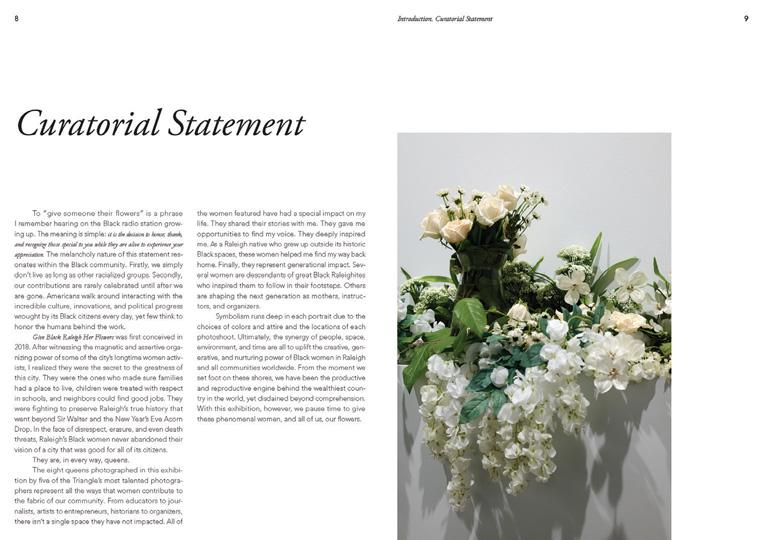
October to December. Then it was time to work on the exhibition catalog. Mike, along with Shelley Smith, the creative director of Anchorlight, was insistent that my writing become part of this whole experience. And I wanted to continue the education, to highlight these women in a way that people could bring them into their homes.
As I was writing, I kept finding more information to add! Soon the exhibition catalog became a book, a whole project of its own. The book includes all of the portraits included in the exhibition, as well as never-before-seen portraits of the Queens. Each Queen has a biography that is tied together with the art, as well as reflections from the artists on the process. Also, I included the official exhibition images by the talented photographer Sally Van Gorder as well as behindthe-scenes photos and pictures from our incredible opening taken by the wonderful Shelley. I included an article that Colony Little wrote about the exhibit for WALTER, as well as notes to explain significant details about the art and artists. The book ties together their histories and current realities —

many of these women are still doing the work that they are being recognized for. Raleigh is growing so quickly, and its Black history is getting obscured. I want to spark people’s curiosity, to help them understand where we came from. But it’s fitting that the book has taken this long to write, because now we’ll be releasing it on the anniversary of the exhibition.
I am still experiencing people coming to me and telling me how much that exhibit meant to them. These women felt truly seen and honored. I never in my wildest dreams imagined the reach of this exhibit and work. But I did believe in the power and impact of these women. Getting the opportunity to write this book, thanks to Anchorlight's generosity and the urging of Shelley and Mike, has been a dream come true. These women’s stories are truly remarkable and I’m forever changed by knowing them.
Give Black Raleigh Her Flowers is available through blackoaksociety.com.

It isn’t so much about the final number on your scorecard. It’s about rising to the challenge of Pinehurst No. 2. After all, U.S. Opens are played here. So can you.
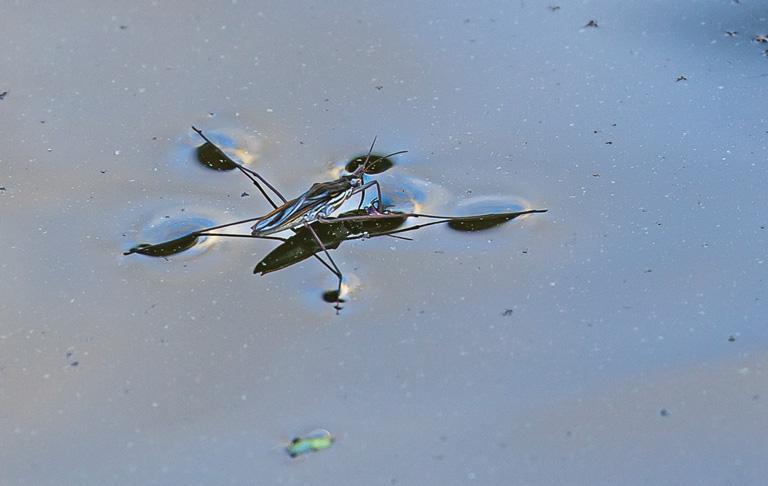

The wonders of water striders
words and photographs by
MIKE DUNNWhen I was a kid, I spent a lot of time roaming the woods and fields at my Aunt Ruth’s place near Whitetop Mountain, Virginia. My folks usually spent a week “back home” in the mountains every summer, and I relished my time wandering around looking for critters. I would wade into the creek in the woods behind her house, flipping rocks to see what lived under them, building dams to create pools and generally doing things kids do in a creek.
There were a few pools where I could spend time with two of my favorite creek critters, crayfish and water striders. I learned to catch crayfish without getting bitten (usually), and spent a lot of time watching the water striders. I don’t remember trying to catch them with my hands, maybe because I wasn’t quite sure what they were.
It fascinated me that water striders could skate across the surface of the creek. And I still love the dimpled shadows they leave on the stream bottom from where their legs rest on the surface film.
Over the years, I have watched water striders catch prey, I’ve caught them in nets, showed them to teachers and students and become accustomed to seeing them on most streams and still waters in our state. But it wasn’t until we refurbished our two water gardens a couple of years ago that I really started to observe, photograph and learn more about these amazing creatures.
Water striders are insects in the category of true bugs (and you probably thought all insects were true bugs, right?), part of the insect order Hemiptera. Other common true bugs include terrestrial stink bugs, cicadas and leafhoppers and aquatic groups like backswimmers and water scorpions. True bugs have piercing mouth parts that they stick into their food (plants or prey organisms) to suck out fluids. There are over 1,700 species of water striders worldwide. Most live in fresh water, although there are a few that are marine insects, spending their lives on coastal seas and the open ocean.
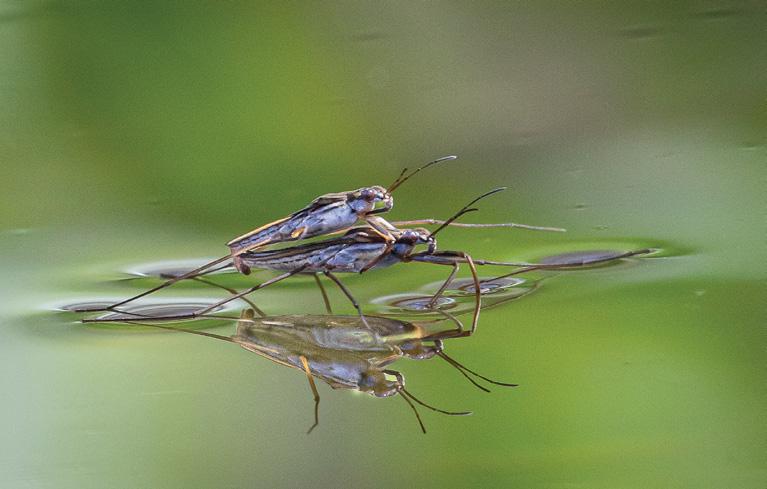
Water striders literally walk on water. This has given rise to a lot of colorful common names like Jesus bugs, pond skaters, pond skimmers and water skeeters. Their slender, lightweight bodies are well-designed for this amazing feat. They spread their minimal weight over a large surface area by having two pairs of superlong legs (the third, front pair is much shorter and used for grasping prey).
Unlike most insects that have claws at the tips of their legs (“feet”), a water strider’s claws are located a bit higher up, so that they do not puncture the surface of the water. But the real key to their success is the abundant microhairs that cover many parts of a strider’s body. There are thousands of microscopic grooved hairs covering the legs and undersides of water striders. The tiny grooves trap air, helping the legs repel water, allowing the insect to push a dimple in the water and take advantage of the surface tension. Scientists are studying these hairs for possible waterrepellent designs for products like rafts, water-based robots and even mini-aquatic spies. (Perhaps they could be called water spy-ders?)
Watch a strider and you will see it uses the front pair of its longer legs as oars.
The hind legs help propel it and are used as rudders. The small front legs grab and hold their prey (usually an insect on the surface). They detect their prey by sensing its vibrations on the water. Much of their food consists of small insects that fall into the water and are trapped by the surface tension. They also feed on other striders (especially young ones) and other invertebrates emerging from underwater, like mosquitos. After grabbing an insect, a water strider will pierce it with its sharp beak and inject digestive enzymes that liquefy its insides. Using a “pump” located inside the strider’s head, it will then suck up the prey’s predigested nutrient milkshake. Yum!
To allay the fears of those of you who like to swim in local ponds and lakes: Water striders are harmless to humans and will not skate over to give you a bite just for fun. One reference claims the mouth parts are too weak to penetrate human skin. (But I’m still not testing that theory by grabbing one in my palm.)
While photographing water striders one afternoon, I saw several mating pairs. Males are generally smaller than females and announce their intentions by tapping the water surface and sending out romantic ripples. Receptive females
“come hither” and they pair up, males on top. I also saw several rejections, with females jumping and flipping the males off. After successful mating, females lay eggs on plant stems or other solid surfaces just under the surface. I have thus far failed to find their eggs to photograph them, but I’ll try again this year (this passes for entertainment in a naturalists’ world). The eggs hatch into tiny nymphs that will molt several times over a few weeks before gaining their adult size.
One other interesting fact about water striders is that within some species they exhibit wing polymorphism: Some have full-sized wings, some have small wings and some no wings at all. It apparently depends somewhat on their habitat. A temporary pool or one that fluctuates greatly will lead to winged individuals that can fly and migrate if the need arises. Those in more stable environments, like large lakes, may not have wings at all.
Even as I’ve learned more about my local water striders, there are still plenty of mysteries. For example, we noticed striders in our newly refurbished ponds the day after we filled them — how do they find new water sources so quickly? Where are those elusive eggs? What do they do in the winter? (Some resources say they hibernate under debris near the water body, others say they spend the winter at the bottom of the pond. Yet another says the adults die after laying eggs, before the first freeze, and new striders emerge from the next spring.) What eats water striders besides other striders? (They may secrete distasteful chemicals that deter predation by fish, but some references list frogs, birds and even fish as potential predators.) Scientists don’t know the answers to many of these questions. If you see me leaning on the rocks around one of our ponds, I might be pondering the mysteries of the bugs that walk on water. Have a look yourself the next time you visit a pond or slow-moving stream. Water striders really are amazing critters.

If you walk into the South Street Mini Mart in Raleigh’s Warehouse District, you should probably stay on your toes — because when you go to grab a candy bar from the shelf or a beer from the freezer, you might just get pranked. The convenience store happens to be managed by Youssiff Boudib, aka MajorKeyLife, a social media sensation who’s earned over 9 million TikTok followers thanks to his highly entertaining, quick-hit videos featuring silly pranks on unsuspecting customers.
A 41-year-old Garner resident of Sen-
Meet Youssiff Boudib, a local retailer who’s become a social media sensationby RACHEL SIMON photographs by TERRENCE JONES
egalese decent, Boudib started posting videos to his channels (which also include YouTube, Instagram and Facebook) three years ago, in March 2020. Like so many others, he was home with his family during the start of the Covid-19 pandemic, looking for new activities to pass the time and trying to stay upbeat. His niece and nephew suggested that he start a TikTok account to post dance challenges, and while he liked the idea of having a creative outlet, he was hesitant to join the platform.
“I said to myself, eh, it’s a kids’ channel,’”
Boudib recalls. But when his boredom hit a peak, though, he decided to give TikTok a chance.
Boudib began uploading videos showcasing everyday life at the store, where he was still working. Before long, one video — of a shopper hitting the jackpot on a scratch-off lottery ticket — went viral, earning over a million views. Boudib, an entrepreneur at heart, was keen to capitalize on the moment.
“Once I started seeing the views rise up, then I had other ideas and started putting my own creativity into it,” he

says. “And it just started growing.”
That creativity took the form of pranking — silly antics like squirting water guns from behind the fridges, putting “fart spray” on products to gross out shoppers at the register or sending remote-controlled mice racing around the floor.
The videos of customers’ over-the-top reactions quickly gained traction with viewers. (Having seen too many videos of unsuspecting prank victims grow upset over their involvement and not wanting a mishap of his own, Boudib now primarily focuses his attention on family, friends and the store’s repeat customers.)
When he started using his now-popular catchphrase, “it’s night-night time,” after one especially surprised customer dropped to the floor, the videos’ popularity skyrocketed. They got even more popular when his longtime friend Ronnie Perry, aka “Uncle Rich,” began appearing in the clips, either as a game prankee or an amused accessory to the antics.
“One day he walked in and started saying some funny stuff, and I happened to record it, and once I posted it,
viewers fell in love,” says Boudib of Perry, a 64-year-old Henderson native. “He’s a fan favorite.”
(When asked about his commitment to appearing in his friend’s videos, the far more reticent Perry simply shrugs off his stardom. “I come flying on in here every day, doing the same thing every day. I ain’t got nothing else to do. I’m retired,” Perry says.)
As Boudib’s channels have grown, he’s devoted more time to producing content, often filming and editing at least one video a day in addition to responding to fans and maintaining his website chasingdreams.com (which features MajorKeyLife merch), all while managing the Mini Mart full-time.
“It’s tough,” he admits. “Dealing with working the front and the customers, then filming with Rich or doing my own thing, it’s a balance.”
And although Boudib occasionally craves some downtime, he knows that his viewers expect their regular dose of mood-boosting content. “My fans want to see videos every day,” says Boudib. “If I have a day or two off, my DMs are full” with questions.
Still, he has few complaints, especial-
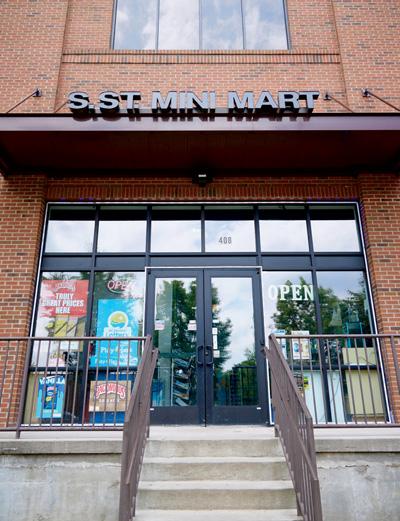
ly because he’s recently started to earn income from his channels and chat with other creators about potential collaborations. The goal, Boudib says, is to eventually expand MajorKeyLife’s reach to more than just the Mini Mart. Referring to both himself and Perry, he says “we’re trying to establish ourselves more to get out there — get better known in Raleigh, get known in Miami, anywhere,” adding that he hopes to also work on other forms of entertainment like podcasts and TV. “We’re just being patient and waiting for the right opportunity, for somebody to come knocking on our door and say, hey, we want you to do something with us,” he explains.
In the meantime, Boudib says he’s more than happy to keep pranking around the store, posting his videos and connecting with his fans, both online and around Raleigh, where he and Perry are both increasingly stopped for photos and autographs.
“Our community knows who we are and knows what we do. They just want us to continue pursuing our dreams and taking it further,” he says. “We’re just here to make people laugh, and to make this world a better place.”
Come summer, we’re dreaming about pools, rivers and beaches — and so are these North Carolina musicians
by DAVID MENCONISummer is the wettest time of the year, and not just because of the humidity. It’s when we tend to spend the most time around bodies of water, whether it’s alongside the Atlantic Ocean, down by a lazy river or hiking toward a waterfall.
In honor of this most aquatic of all seasons, here is a playlist of North Carolina acts from over the decades, doing songs in which water plays a starring role.
THE FOREIGN EXCHANGE (FEATURING CARLITA DURAND), “DREAMS ARE MADE FOR TWO” (2013) In this dreamy tune, Phonte Coleman, the cofounder of North Carolina hip-hop legends Little Brother, croons about scenic beaches. They’re lovely, of course, but, the lyrics ask: “Who wants to view it alone?” Summer getaways are as much about who you’re with as where you’re going.
LET’S ACTIVE, “WATERS PART” (1984) Waters can rise, recede or divide. And on rare occasions when the interpersonal chemistry is just right and the planets align, they part. Let’s Active frontman/guitarist Mitch Easter notes the movements of moons and tides before concluding, “Waters part when our eyes see together.”
SYLVAN ESSO, “SLACK JAW” (2017) Water can also stand in for things you’re trying to keep your head above. “Slack Jaw,” a moody downtempo song from Durham electronic duo Sylvan Esso’s splendid What Now album, finds vocalist Amelia Meath sounding shellshocked
DREAMS ARE MADE FOR TWO
The Foreign Exchange
WATERS PART
Let’s Active
SLACK JAW
Sylvan Esoo
COPPERLINE
James Taylor
I THINK IT’S GOING TO RAIN TODAY
Nina Simone,
RIVER’S JAW
H.C. McEntire
BLACK RIVER SWAMP
Link Wray
DOWN BY THE EDGE OF THE SEA
Coastal Cohorts
DEEP RIVER BLUES
Doc Watson
WATERBOUND
Rhiannon Giddens & Francesco Turrissi
DEEP SEA DIVER
Brownie McGhee
THE SWIMMING SONG & WESTCHESTER COUNTY
Loudon Wainwright III
THE FISHIN’ HOLE

in the wake of some unspecified calamity: “Sometimes I’m above water/ But mostly I’m at sea.”
JAMES TAYLOR, “COPPERLINE” (1991) Sweet Baby James spent his formative years growing up in Chapel Hill. “Copperline,” co-written with North Carolina novelist Reynolds Price, is a fond remembrance of summer days spent splashing around Morgan Creek. Nowadays there’s a sign reading James Taylor Bridge on a stretch of Highway 15-501 across that same waterway.
NINA SIMONE, “I THINK IT’S GOING TO RAIN TODAY” (1969) Sometimes water does not rise from below but falls from above, whether or not you’ve got outdoor plans. Tryon native Simone covered this Randy Newman classic about a mood as grimly dark as an afternoon thunderstorm that blacks out the sun.
H.C. MCENTIRE, “RIVER’S JAW” (2020) Singer/songwriter McEntire’s 2020 album Eno Axis uses the song to explore the Orange County river she’s lived alongside for nearly a decade. Possibly the most aqueous-sounding song on it is “River’s Jaw,” with atmospheric spaghetti-western soundtrack vibes that sound like you’re hearing them underwater.
LINK WRAY, “BLACK RIVER SWAMP” (1971) A master of dirty roots-rock guitar, Wray grew up in the vicinity of Dunn. And while his childhood was not entirely happy, he remembered those days enough to write these lyrics: “I can
hear them bullfrogs croaking/ In the blackness of the night/ Calling me back to my childhood/ Down here in Black River Swamp.”
COASTAL COHORTS, “DOWN BY THE EDGE OF THE SEA” (1996) Coastal Cohorts are a spinoff from the eclectic Chapel Hill stringband Red Clay Ramblers, and they’re best known for the 1996 musical King Mackerel and the Blues are Running. From that musical, “Down by the Edge of the Sea” is a zippy, finger-snapping number.
DOC WATSON, “DEEP RIVER BLUES” (1964) A folk-guitar legend from Deep Gap, Watson could play lightningfast yet still make it feel as relaxed as ambling alongside a lazy river on a hot summer day. Recorded in 1964, “Deep River Blues” stands as proof that sometimes pretty surroundings aren’t enough to cheer you up.
RHIANNON GIDDENS & FRANCESCO TURRISSI, “WATERBOUND” (2021)
Equal parts classical siren and downhome banjo player, Greensboro native Giddens just won a Pulitzer Prize for her opera Omar, written with Michael Abels. But as far as she’s traveled, home is never far away in her music. From her most recent Grammy-winning album, They’re Calling Me Home, “Waterbound” contemplates water as a barrier “down in North Carolina.”
BROWNIE MCGHEE, “DEEP SEA DIVER” (1960) A song that puts the “body” into “body of water” as metaphor. It’s a ribald little tune in which Piedmont blues legend McGhee boasts of his prowess as a lover.
LOUDON WAINWRIGHT III, “THE SWIMMING SONG” AND “WESTCHESTER COUNTY” (1983) Swimming pools are a recurring location for Durham na-
tive Wainwright, including “The Swimming Son” from his Attempted Mustache album. A decade later, he offered up the song “Westchester County,” on which he intones, “We were richer than most/ I don’t mean to boast/ But I swam in the country club pool.”
“THE FISHIN’ HOLE” (1960) We close with this easy-going whistled instrumental, which you might know as the theme song to The Andy Griffith Show. The long-running television series went off the air in 1968 but is no doubt airing in syndicated reruns somewhere at this very moment.
LISTEN UP!
Find a link to this Spotify playlist on waltermagazine.com













Intimate, lush and allegorical, Jennifer Meanley’s paintings are large-scale depictions of human experience. Figures, often out of scale with their environments, gaze at odd angles within kaleidoscopic settings, more consumed with their interior lives than with the scenes they inhabit. Animals, alive and dead, sometimes share the space. Something’s clearly about to happen, or might be happening, or perhaps already has happened. Are her subjects aware?
“There is often a sense of lack of synchronicity between
how we experience our bodies and how we experience our mind, our emotional states,” Meanley says. Her paintings “often register that paradox, whether that’s with the animals, or the symbolism with the space itself… or whether the figure seems to be looking and registering and connecting” to reality.
A painting underway on her working wall features a caped, gamine figure gazing upon a flayed animal, possibly a deer, within a riotously overgrown landscape. “I was thinking of this sort of crazy Bacchanal,” says Meanley, a New Hampshire native


who teaches drawing, painting and printmaking at the University of North Carolina Greensboro.
“Or of a surplus, imagination as a kind of surplus.” Anything is possible in the abundant realm of the imagined, she points out. The real world is another matter.
Color plays a major role in her work. “I’ve always had a penchant for really saturated colors,” she says, especially as a way to indicate atmosphere, like light, air, wind and the grounding element of earth. Like poetry, her images reveal themselves in stages and elements: rhythm, tone, vocabulary, story.

So it’s no surprise to learn that Meanley writes regularly in forms she compares to short fiction, a process she describes as “a field that I experience, stepping in and noticing punctuation,
noticing the spaces between things, or the pauses, the way breath might be taken.
That’s all really, really fascinating to me.”
When she’s teaching, she tries to create a corollary to visual language in much the same way. “What does it mean to literally punctuate a drawing, in a way that you would take a sentence that essentially had no meaning, and make it comprehensible?” she asks her students. “In words, you do it through timing, space, rhythm and breath — what are the ways we can do this in art?”
As she grows older, her writing sessions have taken on more importance, Meanley says. Writing “is a way for me to deepen my personal exploration of my own psychic space, which is the origins of the paintings as well.” Though she doesn’t intend
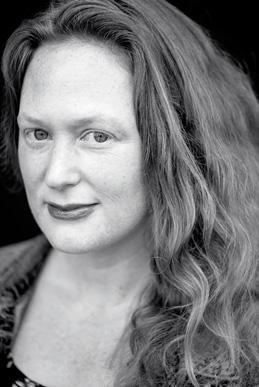
“I’ve always had a penchant for really saturated colors,especially as a way to indicate atmosphere, like light, air, wind and the grounding element of earth.”
— Jennifer Meanley
to publish these writings, Meanley is open to the possibility of including some of her words in new paintings. “I think the world that I’m exploring has to do with the idea of psychological interiority, and how that can find representation” through words and images.
This exploration also connects to physical movement, another practice Meanley credits with fueling her creative process. Long walks with her dog in the woods spark marathon writing sessions, which help inspire drawings and paintings.
They have also attuned Meanley to the natural environment of the South, so different from what surrounded her in New Hampshire, where she earned her BFA at the University of New Hampshire, or even at Indiana University, where she received her MFA. She moved to Greensboro in 2008 for the job at UNCG, and in and around the Triad, she finds nature so lush, so green, so impressive. “I started realizing that there’s this battle within the landscape,” she says. “Just to even maintain my yard, I feel like I’m battling the natural growth here. It did amplify that sense of tension, of creating landscape as a narrative event… as an important space to contemplate hierarchies of power.”
Summer, with its time away from the demands of academia, provides Meanley with more time for outdoor exploration and for contemplations of all kinds. She’s also looking forward to having time to tackle larger works, with the hope of a solo exhibition later this year or in 2024. “Doing a solo show is an endeavor,” she says. “Right now I’m gearing up.”



It started with a simple phone call from our neighbor across the street. Mildred Horseman had seen me mowing my family’s yard and wondered if I might be willing to mow her lawn. Her husband, Gene, was just home from the hospital and under strict doctor’s orders to rest for a month. She even offered to pay.
It was early summer, 1968, and I was 15. We were new to an old neighborhood where everybody had lush green lawns. I’d been mowing lawns since age 12, trusted not to destroy anything or chop off my own toes.
“I’ll send Jimmy right over,” said my mom. “No need to pay him. He loves mowing the grass.”
That was partly true. I liked mowing grass. I also liked money, which I needed to buy the beautiful classical guitar I had my eye on at Moore Music Company. It was a whopping $95, $800 in today’s currency.
So off I went with our crotchety old Sears power mower, which normally took forever and required a number of impolite muttered oaths to start.
Mr. Horseman sat on his screened porch watching me unsuccessfully crank
until I had to rest my arm. He finally got up and stepped outside.
“Jimmy,” he said. “Come with me. I’ve got just what you need.”
In his garage sat a bright green LawnBoy power mower, one of the most beautiful things I’d ever seen.
“She’s got a few years of age on her, but will almost always start on the first pull. I keep her tuned up.”
He was right. One pull and she started. Mr. Horseman went back to his club chair on the porch and I got busy on his lawn, marveling at the way his LawnBoy cut grass.
When I finished and put his mower back in the garage, he waved me onto the porch. Mrs. Horseman had brought out lemonade.
“So what do you think?”
“Great,” I said. “Wish my dad would get one of those.”
“They’re pretty reliable,” he said. “One of the oldest brands in America, invented by a guy who built motors for boats.”
As I drank my lemonade, I learned Mr. Horseman was a retired business professor from Michigan. The LawnBoy mower, he explained, was created before WWII by a Wisconsin man who built Evinrude outboard engines. “I knew him when I was young. He became quite the successful businessman.”
Mr. Horseman handed me a $10 bill. Sadly, I was compelled to explain that I was unable to take his money due to a mother who didn’t care a fig if I became a successful businessman.
“In that case,” he said, “how about we do a deal. You mow my lawn this summer and you can use the Lawn-Boy to mow lawns along the street. Sound good? I’ll even buy the gas.”
It did sound good, a potential gold mine at 10 bucks a clip. But I didn’t know any of the neighbors yet.
“Print up some fliers,” he said. “Or, better yet, I’ll have Mildred get on the phone. You’ll have a job or two in no time.”
had a great laugh and a solid right hook. When I asked her to go to the movies, she laughed and punched me sharply on the arm.
We went to see Franco Zeffirelli’s Romeo and Juliet at the Cinema on Tate Street near UNCG, an evening somewhat diminished by the fact that my father had to drive us to the theater and never stopped chatting with my date.
That summer was long and hot for America, one of the most tumultuous in the nation’s history. Rev. Dr. Martin Luther King Jr. and Sen. Bobby Kennedy were both gunned down by assassins that spring, and an unpopular war in Vietnam took an even ghastlier turn. Race riots erupted in Cleveland, Miami and Chicago.
But it was also the summer that Ginny and I went to see The Graduate, the Beatles released “Hey Jude” and I snagged a second job teaching guitar to kids and senior citizens at Mr. Weinstein’s music store. Between mowing and teaching, my pockets overflowed. I felt flush; I started saving money to buy my first car.
Within a week, I had two paying jobs, and half a dozen regulars by the middle of summer. I was the richest kid on the block.
Within a week, I had two paying jobs, and half a dozen regulars by the middle of summer. I was the richest kid on the block.
By July, the Yamaha classical was mine. My mom took to calling me “Jimmy the Yard King.”
It was my first real job.
I also had my first real crush that summer, on a cute girl from Luther League named Ginny Silkworth. Ginny
And something about the orderliness and smell of fresh-cut grass and the satisfaction of a job well done permeated my teenage brain. It grounded me in a way that made my narrow world seem oddly immune from all the bad news on TV.
It was the first and last great year of Jimmy the Yard King, though its impact was lasting.
Perhaps this explains why, when my wife and I built our first home, on a high forested hill near the coast of Maine, I created a garden that featured more than half an acre of beautiful Kentucky bluegrass and fescues.
By then I’d graduated to a seriously deluxe John Deere lawn tractor, which gave me more than a decade of mowing bliss. A sad parting came, however,
when we packed up to move home to North Carolina and discovered there was no room in the moving van for my dear old John Deere.
I seriously considered driving my Deere all the way to Carolina, but finally gave up and sold it to our snowplowing guy for a song.
I still have dreams about it.
Today, back in the old neighborhood where I started, I own a modest suburban patch of grass I can mow with my Honda self-propelled mower in less than 18 minutes.
It’s a fine mower, but nothing compared to Gene Horseman’s marvelous Lawn-Boy. Professional lawn crews now roam our streets like packs of Mad Max mowers, offering to relieve me of my turf obligations for 75 bucks, roughly what it once took me a full week to earn cutting grass.
They seem offended by an old guy who loves to mow his own yard.
Sometimes, when I’m cutting grass, I think about that faraway summer and my laughing first date. Ginny and I stayed in touch for four decades. She became a beloved teacher in Philadelphia and passed away a few years ago. I miss her laugh, if not her punch.
Maybe the smell of fresh-cut summer grass does that. Whatever it is, if only for 18 minutes once a week, Jimmy The Yard King is back in business.














ifty years ago, my father conscripted my grumbling brothers and me into the building of a stone monument. China has its Great Wall; Rome has its Colosseum; North Raleigh boasts Big Bill’s Mighty Bulwark.
At 4 feet high and 50 yards long, this retaining wall is composed of roughly 1,000 basketball-sized boulders. It still stands today, dutifully preventing the suburban lawn outside our former home from sliding onto the sidewalk and street below.
This was only the beginning of Dad’s do-it-yourself building spree. In the coming decade and a half, my father would muster his often reluctant brood to construct a sprawling deck, a seemingly endless stockade fence, an entire spare room, an arched pergola with a
by BILLY WARDENrollback swing, floor-to-ceiling built-in bookshelves, a second pergola swooping over a home-poured patio, and an illfated tool shed.
And all this was only at the first of his three homes in Raleigh, after roving South from Chicago in the Great Yankee Invasion of the 1960s and ‘70s.
Now 79, my dad, Bill, is a ranking member of an industrious army of amateur architects, product designers and builders who first took up hammers and screwdrivers in the D.I.Y. surge of the mid-20th century. Popular Mechanics magazine — pretty much modern D.I.Y.’s Book of Genesis — had debuted way back in 1902, extolling the practical and recreational value of making your own stuff. But two world wars and a
depression stinted the supply of time and materials D.I.Y. demands.
The end of World War II, however, brought returning G.I.s newly schooled in gritty self-reliance. This, combined with economic prosperity, the rise of home ownership and a bungling sense of optimism, rallied young families to literally build their dream futures. As a result, the suburban landscape from Raleigh to Rancho Cucamonga is thick with mini-masterpieces and tumbling follies.
My dad, an accountant Monday through Friday, came by the D.I.Y. habit — arguably an obsession — early. His father, my grandfather Lefty, had recruited able Army pals to help erect his budding family’s first home from the ground up upon returning from the battlefields of
Europe in World War II.
Perhaps inspired by this pedigree, Dad’s own construction campaigns took on the character of a military operation. Early in the week, he’d cast a calculating gaze at some unsuspecting swath of yard, like Gen. Patton eyeing an enemy stronghold. Then, come Thursday or Friday evening, he’d hunch over the kitchen table, sketching on a sheet of paper torn from one of our school notebooks.
On Saturday morning, he’d golf, and our little neighborhood would be at peace. But upon returning home, he’d march us boys into our faux-wood paneled Pontiac station wagon to hunt and gather at the nearby construction sites, lumber yards and Ace Hardware. Saturday afternoon and Sunday, we’d build.
Dad’s conscriptions could be overridden in just three ways. First, by a Category Four or above hurricane. Second, by illness — not just signs of a head cold, but actually bleeding from the eyes and
ears. Finally, by the intervention of my sainted mother, Nancy, announcing that one of us brothers-in-arms must go with her to JCPenney or Kmart to shop for school supplies or new clothes. Of course, slipping away like this brought the scorn of the abandoned brothers, but Mom made sure each would eventually have his leave of duty.
On Father’s Day, however, even Mom would join the drilling and cement mixing. And she would openly admire all the things that were in plain sight but too often lost on us boys. How imaginative Dad was in blithely ad-libbing his way through unforeseen glitches and near disasters. How patient he was in teaching us skills we could never quite master. How handsome the finished work was — except for the aforementioned tool shed, which eventually collapsed due to a brown ocean of rain sloshing atop its fatally flat roof.
None of us grew up to be weekend
builders per se. But Raymond took to constructing his own electric guitars en route to a career in music. Christopher just bought a house in the country where he foresees much backyard puttering. And I like to think that the many journalism pieces I’ve authored are, in a way, sawdust-free construction projects (complete with the occasional conniption of cursing that Dad also specialized in).
My folks now live in the dream home that Dad designed for their retirement in 2010. His plans for the contractors included an unfinished second floor. Naturally, almost as soon as the professionals cleared out, Dad proceeded to finish the upper level himself with stupefying care and flair. Puzzling over the logic of sending the pros home only to bootstrap a major project solo is beside the point. Adventures in D.I.Y. don’t have to make sense, they just need to make the creators happy and the lives of the people around them a little richer. Mission accomplished, Dad.

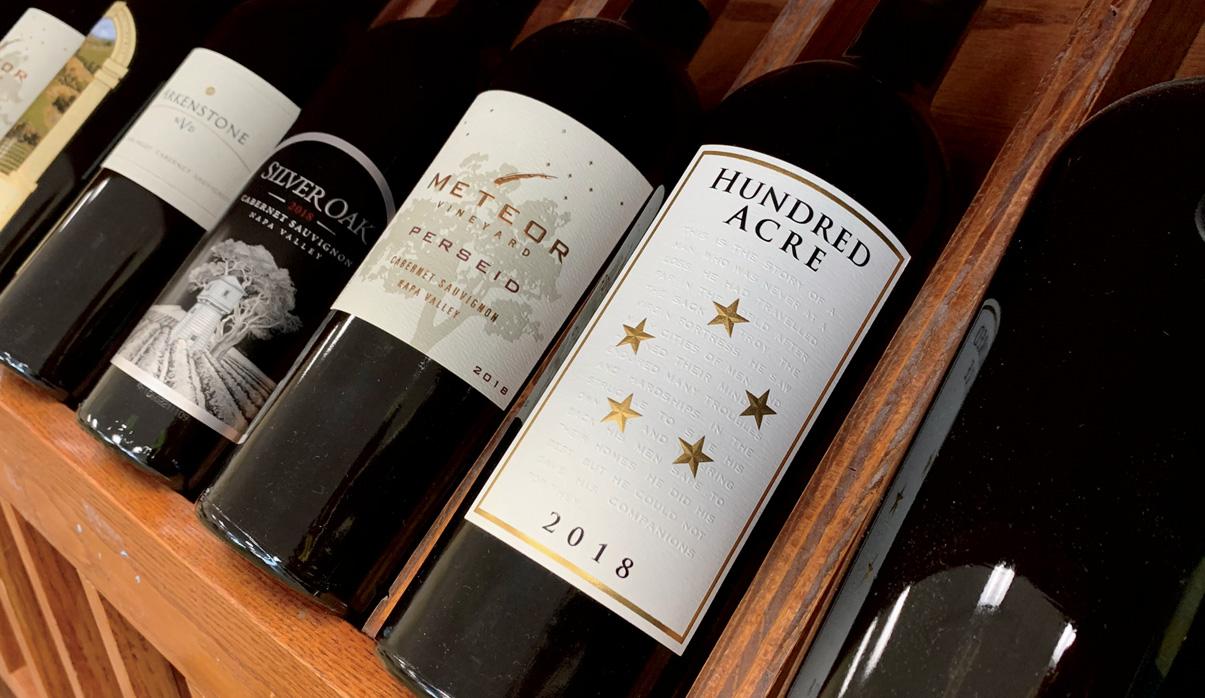


“The ultimate beach read!”


‘Tis the season for long days and balmy nights. Those extra hours of sun give us energy to enjoy each day to the fullest. Whether your idea of the perfect summer day is an outdoor excursion, a symphony under the stars or an air-conditioned performance, the Triangle has lots to offer.

MONDAYS – FRIDAYS 10 A.M. – 6 P.M.
SATURDAYS 10 A.M. – 6 P.M.
SUNDAYS 12 – 5 P.M.
2017 Cameron Street, Raleigh
It’s no secret that North Carolina has an abundance of summer getaways — and Great Outdoor Provision Co. has the gear you need for endless summer fun.
Start the day on the water on a standup paddle board, step into a stream with a fly rod or relax at golden hour in the comfort of functional clothing and timeless design. Much of GOPC’s clothing is made with sustainable practices, like everyone’s favorite shorts, the Patagonia Baggies (shown here). They are now made with lightweight durable 100% recycled nylon or hemp and organic blend.
From camping to kayaking to simply enjoying making the most of the outdoor oasis in your background, you’ll find everything you need at Great Outdoor Provision Co.
Visit greatoutdoorprovision.com or call 919-833-1741 for more information.

Mary Poppins
JULY 25 - 30
Raleigh Memorial Auditorium
Martin Marietta Center for the Performing Arts
2 E. South Street, Raleigh
Everyone’s favorite nanny returns! Disney and Cameron Mackintosh’s Mary Poppins is based on P. L. Travers children’s book and the 1964 Disney film. This musical is an enchanting mixture of irresistible story, unforgettable songs, breathtaking dance numbers and astonishing stagecraft!
In this classic story, Mary Poppins flies into 1910 England to attend to the troubled Banks family. Using a combination of magic, games and common sense, she must teach the family members how to value each other again. Mary Poppins takes the children on many supercalifragilisticexpialidocious adventures, but Jane and Michael aren’t the only ones upon whom she has a profound effect.
Even grown-ups can learn a lesson or two from the nanny who advises that “Anything can happen if you let it.”
Tickets start at $35. Visit nctheatre.com or call 919-831-6941 for more information. Sponsored by ABC11, PulseFM and Kix102FM.
MARY POPPINS is presented through special arrangement with Music Theatre International (MTI). All authorized performance materials are also supplied by MTI. www.mtishows.com. Flying Effects provided by ZFX.

MEMORIAL DAY WEEKEND
THROUGH MID-JULY
Koka Booth Ampitheatre
8003 Regency Parkway, Cary
For more than 20 years, families and friends have packed their picnics and gathered under the stars for the North Carolina Symphony’s summer series. It offers audiences the best in music and entertainment in a relaxed, fun outdoor setting.
This UNC Health Summerfest season features Opening Night with Tchaikovsky’s Symphony No. 5, an evening of All Beethoven, A Little Night Music with Mozart and Classics Under the Stars featuring works by Mozart, Mendelssohn and more.
A night of fiery Tango Caliente will feature guest vocalist Camille Zamora and dancers Patricio Touceda and Eva Lucero.
Pops concerts include The Music of Whitney Houston, Fire and Rain — songs of the 1970s featuring music of James Taylor, Fleetwood Mac and more — plus, an epic celebration of the music of Harry Potter and Star Wars. And Cirque is back with cinematic favorites featuring high-flying acrobats.
Tickets start at $32; kids under 12 free on the lawn. Visit ncsymphony.org or call 919-733-2750 for more information.

JUNE 8 -10, 15 - 17 AT 7:30 P.M.
JUNE 11 & 18 AT 3 P.M.
Theatre in the Park
107 Pullen Road, Raleigh
Queen Elizabeth is dead, and her favorite courtier, Sir Walter Raleigh, is facing the executioner’s blade. A larger-than-life character, Raleigh meets his fate with wit and aplomb, despite a court of vipers and a jealous king intent on bringing his downfall.
Raleigh, the play about this story, was written by local actor and director Ira David Wood III, and he stars in the title role. According to a review in the former Raleigh Times, “Ira David Wood III has given audiences many memorable moments. But none perhaps is so poignant — or so uniquely his own — as Theatre In The Park’s stage biography of Sir Walter Raleigh.”
Learn a little more about our city’s namesake with this witty intpretation of his surprising history.
Tickets start at $23. Visit theatreinthepark.com or call 919-8316058 for more information.






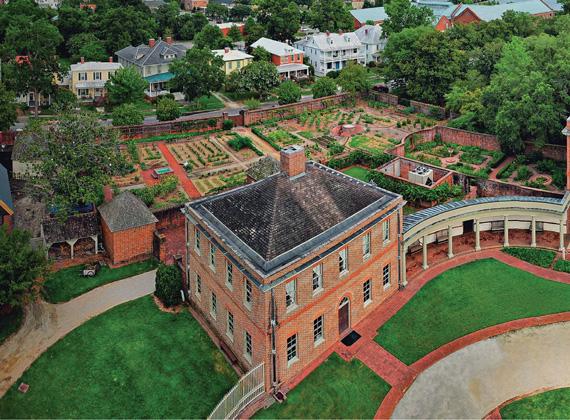





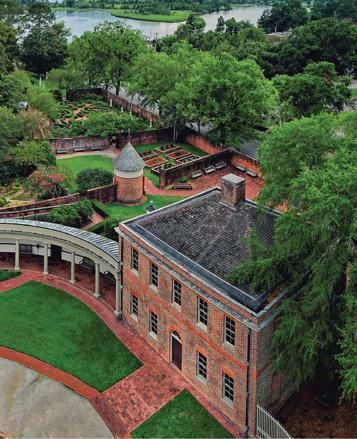
www.tryonpalace.org
529 South Front St. New Bern, NC 252.639.3527


Experience living history. Walk in the steps of the governors who lived at Tryon Palace during the 1770’s – a time of intellectual and political turmoil. Tour the Palace, Kitchen Office, Stable Office, and our 21 acres of beautiful gardens. Visit with the 1st Regiment NC Continental Line at their encampment and learn what 18th c. military life was about. Tour the historic Dixon House and learn about a family from the early 1800s. Visit the New Bern Academy where the 35th U.S.C.T. first mustered. Throughout the year, there are specialized tours, lectures, and events such as our “Life on the Lesser Stairs” tour, Garden Lecture Series, African American cultural programming, and monthly Outlander tours. Enjoy enriching exhibits at the NC History Center. Learn about colonial spinning and weaving, apothecary, dueling, African American artisans, and eastern North Carolina’s history. Experience Tryon Palace.


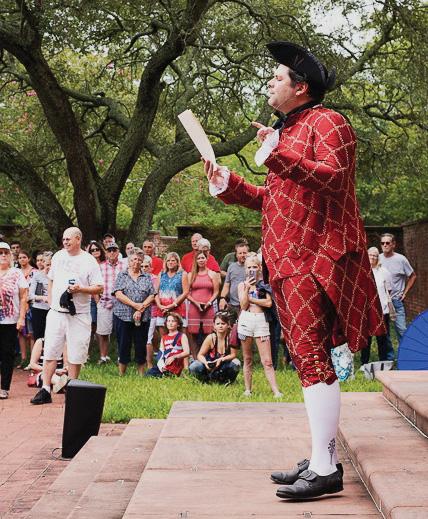
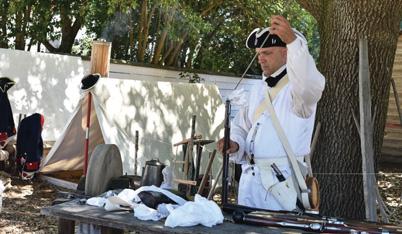

We are the breath the skin the muscles the heart the hands the unmeasurable bones whispering across the Atlantic Ocean. We are the bellies of Middle Passage ships. We are blue door of no return on Goree Island. We are the mornings that broke with our living and our dead fastened together. We are the eyes bearing witness to sharks following our human cargo waiting for the feast of dead or sick bodies tossed overboard. We are the shadows in the back of the eyes of daughters throwing themselves and their babies overboard. Our blood is the red that stole the blue of the ocean. We are scattered bones rising up from the bottom of the Atlantic revealing a pathway marking the route. We are the fruit of those bone trees planted deep in the fertile Atlantic. We carry a DNA of survival, strength, extraordinary will. From forced migration to slave market we are all the links of all the chains of the past and future. Binding spiritual links from the bones in the Atlantic to the bones of slaves in a place like Galveston Texas where ancestral whispers became the wind… Caressing tired bones with a timeless spirit of rebirth and love. The wind heard first. Whispering from the trees, from the ground beneath their feet, whispering…
Freedom
Freedom
Freedom
The wind knew and rattled tiny bones beneath the feathers of birds. The wind knew. Giving voice to the rain falling creating fertile freedom ground. The wind whispered to every butterfly, every insect pollinating from flower to flower. Freedom. Freedom. Freedom. Eagles stopped in midair to listen to the wind’s song… Freedom came today. Freedom came today… And because our people are a chosen people we could understand the dance of the trees, the tremble of the water. Hoes stopped striking. Hands stopped picking. Feet stood still. A mighty storm named freedom rained over them. Soaked them clean. Mothers kissed hope into the air above babies’ heads. Grandmothers and grandfathers stretched prayers into a sky that would not bend. Men asked where will this freedom live. Children asked what does this freedom taste like. What does this freedom smell like. What does this freedom sound like. What does this freedom look like. Mama, tell me what this freedom gonna feel like. We screamed a jubilee into the clouds. We shed the skin of a slave. We shed the rags of a slave into the river. Our freedom skin was a shining brand-new nakedness that outshined the sun. We be clothed in freedom’s gold. On Juneteenth dead bones came alive and flew on the wings of Sankofa birds all the way back to the river where blood is born… All the way back to the womb that never forgets. We are the Juneteenth resurrection… We are the ancient prayers answered. We are the cup overflowing inviting generations to this feast of freedom.




This month, pitmaster Ed Mitchell and his son, Ryan Mitchell, released Ed Mitchell’s Barbeque. It’s a cookbook that’s less a how-to than an exploration of the craft: What are the roots of barbeque? Who honed the techniques, and why? Can the next generation embrace this tradition and move it forward?
“It was an easy story to write — it’s truly about our own experience,” says Ryan. The Mitchells wrote in collaboration with Zella Palmer, who spent months interviewing them, along with family and friends, to capture their stories and recipes. “Zella spent weeks just with my grandma in the kitchen. All her food is freehand, she didn’t have anything written down,” says Ryan.
 introduction
introduction
by

 AYN-MONIQUE KLAHRE
AYN-MONIQUE KLAHRE
portrait by EAMON QUEENEY
book photography by BAXTER MILLER
Inside, Ed shares a slew of his own recipes, from his whole-hog method to his approach to barbeque chicken to sides, desserts and libations. He also shares family recipes and ones from people he’s worked with, like John Hellwig, Ed’s chef at Que in Durham. “It was really important to us to bring in other people,” says Ryan. “Recipes are so specific, you can get five friends together and argue about whose grandma makes the best fried chicken.”
Throughout, the Mitchells emphasize that the flavors and traditions of barbeque — cooking slowly, dousing meat in strong sauces, pickling trotters or snouts — were a response to a need. “Whole-hog barbeque is a form of survival, a means to feed a group of people,” says Ryan. Essays and historical photos drive the point home.
Ryan and Ed will be on book tour this summer and plan to open a new restaurant in Raleigh, The Preserve, late this year. They found a location off Wake Forest Road that’s zoned both industrial and commercial, so they can smoke a whole hog on-site, the way it’s been done for generations. Just like in the cookbook, they hope the restaurant will encourage folks to come together and get a fuller appreciation for a long undersung craft.
“We wanted to make sure we highlighted the origin of barbeque and give voices to the people who really started it,” says Ryan. “We wanted to paint a picture but also tell the truth and give some motivation at the same time. Barbeque is too inclusive to be divisive.”
“I Can’t Give Up” by ED MITCHELL
My journey into the barbeque business began with a lunch I made for my mama. It was 1991. I was a forty-five-year-old man grieving the loss of my hero and trying to survive without the patriarch of our family. I hadn’t realized my father was as sick as he was. He had terminal cancer, and one night he just slipped away. My mother called me and I came home quickly to be with her. He and Mama had been a team — Black entrepreneurs in a racially divided part of North Carolina. Their grocery store, Mitchell’s Supermarket, was filled with everyday goods from penny candy to cooking oil. It was a symbol of African American progress and Black-owned business.
But without my dad there, friends stopped popping by, and business slowed down.
Early that morning, I dropped by the store to check in on Mama. She wasn’t herself. Ever since my dad’s death, my mom hadn’t been as jovial as she used to be. I will never forget when she told me, “I’ve been here all day and I only sold seventeen dollars in food.” I knew I had to step up and take care of my mama as the eldest son in the family. I didn’t mind — I’ve always been a mama’s boy. I wanted to make my mother feel better and let her know that she could count on
me. So I did what came naturally to us Mitchells: I asked her what she wanted to eat. Mama said, “I have a taste for some good old-fashioned barbeque.”
I knew what that meant, so I got my hands on a thirty-five-pound pig — that’s a small one. I rolled my parents’ rustic cooker into the parking lot of their grocery and fired up the coals.
While the pig cooked, Mama prepared some Eastern North Carolina coleslaw and slowly braised collards. Soon, the smoke filled the air and the pork skin started to crackle. We seasoned and chopped it up on the meat counter in the back, and the fresh barbeque smell permeated the storefront. Our customers, the few we had left, asked, “Y’all selling barbeque now?” Mama looked at me in silence for a moment, then said, “Yes, we are selling barbeque.” She fixed the customer a barbeque sandwich. They must have told a few others, because soon we had a line form and all thirty-five pounds of our hog was gone.
That evening, as I was closing up the store, I heard someone shaking the door. Thinking we were about to be robbed, I put on my best James Earl Jones voice to address the intruder. Low and behold, it was a customer from earlier trying to get another barbeque sandwich. I told him, “We don’t have any more barbeque but we will have some more tomorrow.”
Wilson, North Carolina, is no stranger to barbeque. I would say our small rural town is a founding bedrock to the
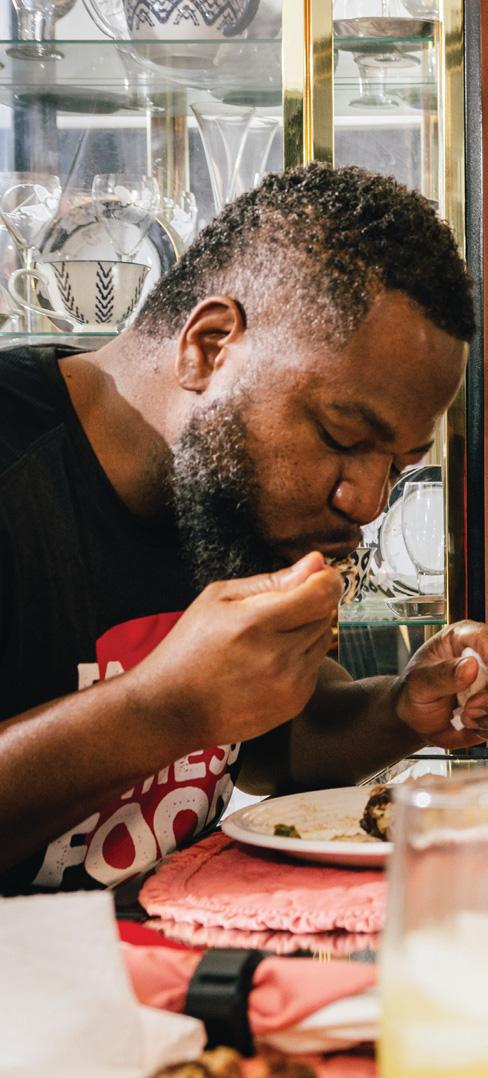
tradition of whole-hog barbeque and growing tobacco. It’s home to two of the largest barbeque joints in the state, Parker’s Barbecue and Bill Ellis Barbeque. Parker’s claims to serve roughly 20,000 pounds of barbeque weekly.
However, with the commercialization of the food industry starting in the 1960s, locals no longer barbequed the traditional way, using natural, farm-raised hogs. Most barbeque restaurants were using store-bought, farm-raised pork shoulders, cooked over gas instead of coal fires, and the flavor wasn’t the same.
The next day, I bought a slightly larger pig and repeated our whole-hog-barbe-

que-for-sale experiment. Little by little, our production increased. I put aside my other hustles and decided to help my mama full-time, building the business with my brothers, Aubrey and Stevie. By the early 1990s, I had transformed Mitchell’s Supermarket into Mitchell’s Ribs, Chicken & Bar-B-Q. We never looked back.
I had no idea that lunch with Mama would shape the rest of my life —that my family’s Eastern North Carolina barbeque would take me around the world to become one of the most internationally recognized barbeque pitmasters. From 2002 until 2018, I was invited year after
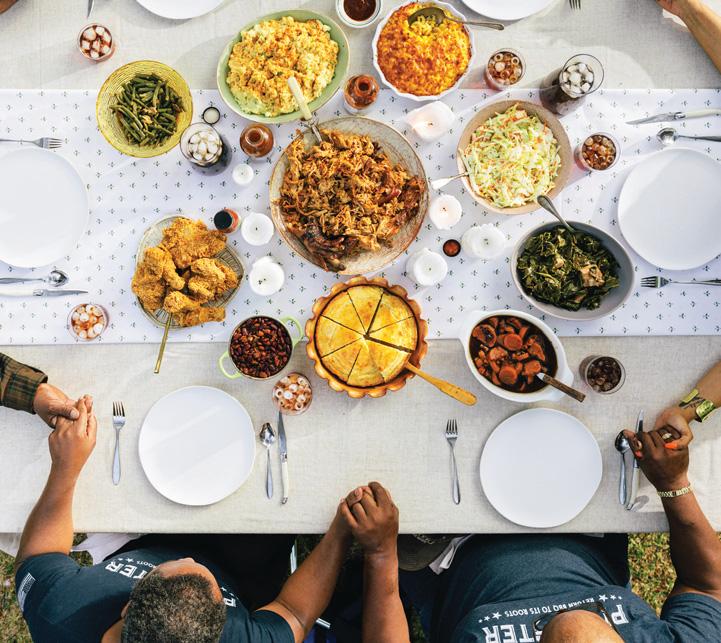

year to headline the Big Apple Barbecue Block Party in New York City. Famous food writers like Michael Pollan and Peter Kaminsky, and chefs like Anthony Bourdain and Bobby Flay, traveled to Wilson to learn how Ed Mitchell, Willie and Doretha’s son, cooked whole hogs, the traditional way.
I never considered the possibility of making a living as a pitmaster because barbeque was just a way of life for us.
Clockwise from top: Eric Lund, manager of the SECU Dinolab; looking at samples; fossils in packets in the museum’s storage area; fossil preperator Aaron Giterman.
We celebrated it through family, church functions, and events. No one I knew who actually owned anything had ever made a career of it. All the Black men I knew had to stay in the back, cook, and keep their heads down — they weren’t allowed to own businesses.
Yet what Mama and I saw that day at our lunch was a way to bring customers back and make them proud of our heritage. Barbeque was the answer to our prayers. It kept our family afloat, both financially and spiritually. I will never forget that moment when everything changed for our family.
It felt like my grandfather and father were my guardian angels.
For me, barbeque has always been synonymous with celebrations. When I was a kid in the 1950s, we barbequed to celebrate family achievements and things like the end of the tobacco harvest season. It was the only time during my childhood when Blacks and whites ate side by side. For a brief moment, we were colorblind, and I never forgot that feeling. The next time I experienced it was in Vietnam, when guys around me were being wounded and killed. The only way we were going to get home alive, besides our prayers, was by watching one another’s backs. I’ve realized that when we have a common need to exist, everything else goes out the window: color, ethnicity, religion, gender, anything that can be divisive.
Barbeque still has that power today. Drive an hour southeast from Wilson to Pete Jones’s Skylight Inn BBQ in Ayden, North Carolina, and inside you’ll see whites and Blacks eating whole-hog barbeque together. In my generation,
that particular part of North Carolina was rife with racial tension, and for our safety, we stayed away as much as possible. Today, you see Black, whites, and every color eating barbeque together. Every time I go down there, I think of that.
And yet for many, barbeque is a topic as controversial as race or religion. Together, these make up three pillars of our Southern identity that are intricately linked — each person fervently believing that his or hers is the best. Each region stakes claim to its own barbeque style based on animal type, cut of meat, charcoal, wood, and sauce.
I’ve tried, as many pitmasters do, to embrace these differences and focus on the beauty of what barbeque means — peace and good eating. As a result, I’ve often overlooked the fact that to me, barbeque is African American food.
quing whole hog today? Rodney Scott in Hemingway, South Carolina; Dr. Howard Conyers in Manning, South Carolina; and Bryan Furman in Atlanta, Georgia are some of the great ones. But look around. Most of the pitmasters on the barbeque circuit are white. There are countless books on barbeque, but show me an African American author telling the story of his or her ancestors and their food. Is it because African Americans consider this type of work too reminiscent of the servitude of their ancestors, or is it because starting a barbeque restaurant today takes hundreds of thousands of dollars? Systemic racism permeates the food and agriculture business, so resources and interest play a part. I reckon it’s a bit of both.
As far back as I can remember, and even still today, Black-owned restaurants in Wilson would sneak a barbeque
“I’ve tried, as many pitmasters do, to embrace these differences and focus on the beauty of what barbeque means — peace and good eating. As a result, I’ve often overlooked the fact that to me, barbeque is African American food.” — Ed Mitchell
My enslaved ancestors stood over their enslavers’ pits. They were always connected to the land, by force and by ancestral wisdom they carried over on ships. They grew collards in their small gardens, and those collards provided the vitamins for them to survive through the worst of times. Plantation owners handed offal — chitlins, pickled pigs’ feet, snouts, and ears — to the field hands. And the enslaved cooked them to perfection, until they became delicacies. My matriarchal ancestors were plantation chefs, the skilled cooks who created the soul food that fed the American South from the mid-1600s until well after the antebellum period.
So why, then, are only a handful of African American entrepreneurs barbe-
sandwich on the menu and serve it as a side. We just knew that they had the power to make sure that we never owned a full-scale barbeque restaurant even though we were doing all the cooking at every plantation barbeque and political rally, and in their kitchens. After Daddy died in 1991 and I decided barbeque was my career and legacy, I got in it to win it. When we designed our menu, we were intentional about adding dishes that we served in our home. Traditional dishes that so many Black families in Wilson ate at home or at a pig pickin’, a traditional North Carolina barbeque. Daily, we served collard greens with backbones, ribs, pigs’ feet, cracklin’, and so much more. My son, Ryan, got involved out of necessity. Now that Mitchell’s BBQ was a
full-time job, we needed all hands on deck. I insisted that he learn the craft and earn those Air Jordans his generation loved to wear.
I barbeque not because I love hoisting 150-pound hogs over my shoulders, but because I want to keep the tradition of my African American ancestors alive. My decision to team up with my son was strategic. The minute he showed interest in my work, I wanted him involved, because barbeque has always been a family affair to me. I wanted him to come home after he experienced working for corporate America. I needed Ryan’s help to move this family business forward.
When he was in college, Ryan told me, “I want to own five or six restaurants.” I encouraged him to pursue a degree in business and economics so he could help me run the restaurant, reminding him that the family business was his legacy. I was so glad that he came on board to help me out. I know a lot of fathers whose children aren’t interested in the family business. God truly blessed me. It was challenging for me without his help. I was tired. The management side, on top of cooking every day, was a lot to manage.
Today, I barbeque to show young African Americans that our history lies in those embers. I wear overalls and a baseball cap, like those worn by my grandfather Lawyer Sandars and other Black men from previous generations, to remind me of the sacrifices of the men who wore this uniform, who worked the land and provided for their families. It makes me realize that the work I do, while it can seem futile at times, is important. After all, I am one of the last barbeque pitmasters who knows how to cook a whole hog like my ancestors did.
This is an excerpt from Ed Mitchell’s Barbeque by Ed Mitchell and Ryan Mitchell, published by Ecco on June 6, 2023.

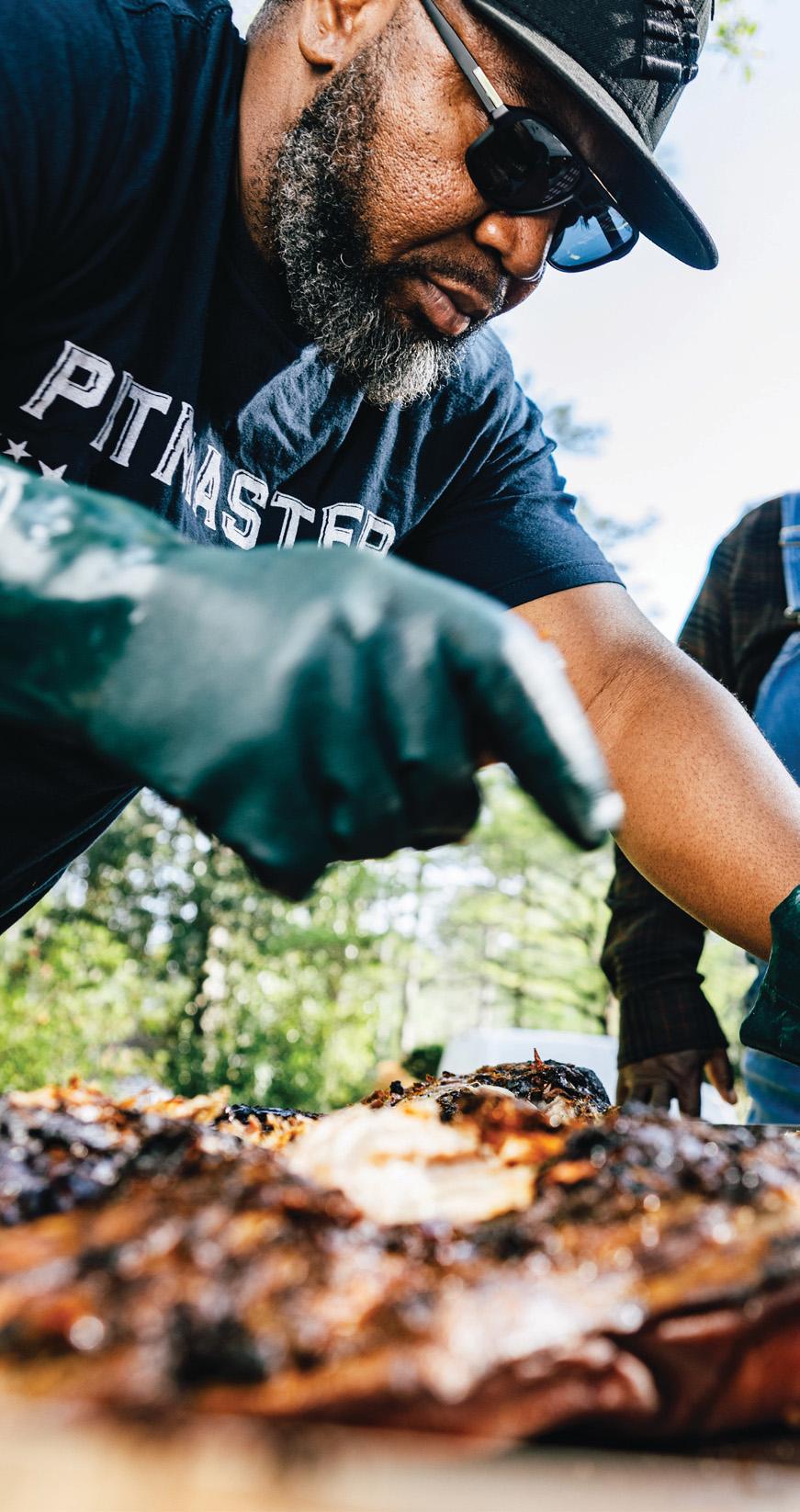

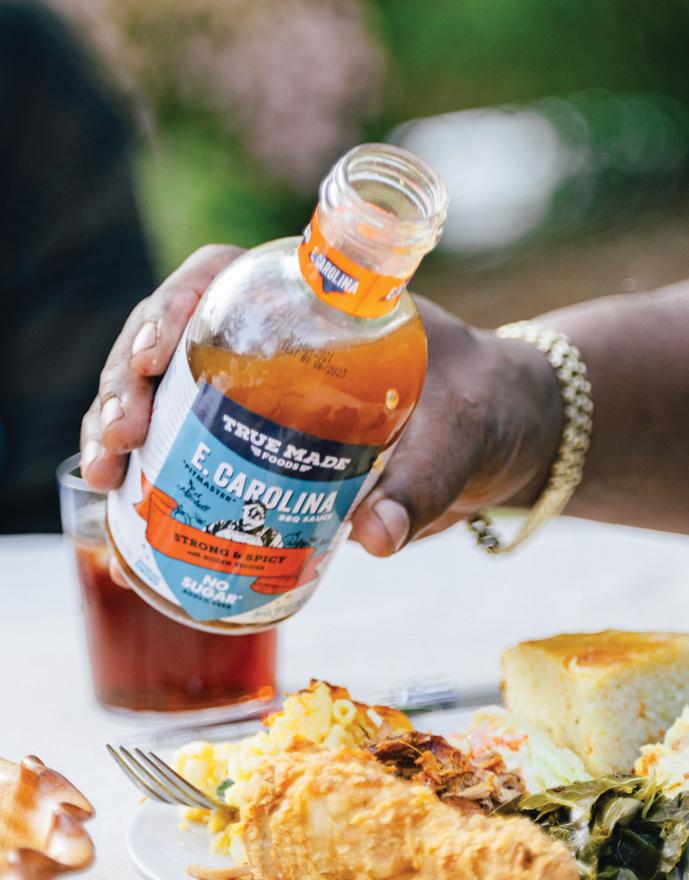
My mother taught me how to make our vinegar barbeque sauce. I can still remember the smell of the tangy sauce boiling on our stove when I was a child. In Eastern North Carolina, there are two styles of whole-hog barbeque: The first is the festive pig pickin’, where a barbequed pig that’s been slathered with sauce is set on a bar and people pick off what they want. The second is when the whole hog is chopped—the meat is pulled from the bones and skin, the skin is toasted into cracklin’, and the meat and cracklin’ are then chopped up and seasoned.
The same ingredients — cider vinegar, brown sugar, salt, black pepper, and red pepper flakes — are used to season both styles of whole-hog barbeque. However, for the pig pickin’, the sauce is mopped on the pig during the final hour of cooking. For the chopped barbeque, the sauce ingredients are added to the meat one at a time, just before serving. We recommend using this sauce to season whole hogs for a pig pickin’, barbequed whole turkey, or baby back ribs. It makes about 1 gallon of sauce, enough to season one 150-pound hog, three 18- to 20-pound turkeys, or 8 racks of ribs.
1 gallon apple cider vinegar
1 cup red pepper flakes, plus more if needed
1 cup packed dark brown sugar, plus more if needed
1 cup hot sauce (preferably Texas Pete or Frank’s RedHot), plus more if needed
½ cup smoked paprika
¼ cup kosher salt, plus more if needed
2 tablespoons freshly ground black pepper
1 tablespoon minced garlic
Combine all the ingredients in a container and stir until the sugar has dissolved. Taste and add more salt, red pepper flakes, hot sauce, or brown sugar to suit you. Just before applying, strain the sauce through a fine-mesh sieve. Serves 12.

A Morrisville garden links this couple to their roots in Zimbabwe and beyond


In the backyard of Berry and Dick Hayter’s home, crimson and gold gloriosa lilies dance like flames. This spring-planted bulb is a darling of the garden, partly because it’s the national flower of Zimbabwe, where both Berry and Dick were raised. “That’s something I miss about Africa, how colorful it is,” Berry says. “I am often trying to recreate the colorful environment I grew up in.”
The Hayters have lived in England, Texas and Colorado, but settled in Morrisville with their two young children in 1998. Ties to their past are visible throughout their property: beloved tropical plants of their childhoods are interwoven with English-style features like mossy stone masonry and a bench tucked into a shady nook, surrounded by ferns. A star jasmine vine grows up a pine tree, azaleas bloom in the shade of southern Africa-inspired banana and palm trees, and a metal sculpture of a warthog perches by a lotus-filled pond. “I remember toting the warthog to the States from Zimbabwe in a carry-on suitcase, its metal legs protruding in all directions,” Berry laughs.
Her father worked in the Rhodesian Ministry of Agriculture as a research scientist, and her parents tended an impressive home garden, growing heaps of food and rows of dahlias, which often won prizes in local competitions.
“We didn’t have TV growing up and it was a very outdoor lifestyle. I spent a lot of time making forts, mud pies and little gardens,” Berry says. “My parents were always interested in how much rain we were getting and had a big compost heap. They’d weed together for fun on the weekends.”
In the Hayters’ garden, towering dahlias in warm shades of red, orange, pink and purple are tucked among the gloriosa lilies. “The garden is a connection to my past,” Berry says.
In summer, the Hayters’ garden bursts with tropicals like elephant ear, coleus, caladium, impatiens and hibiscus. In the cool seasons, Berry loves tending English cottage garden






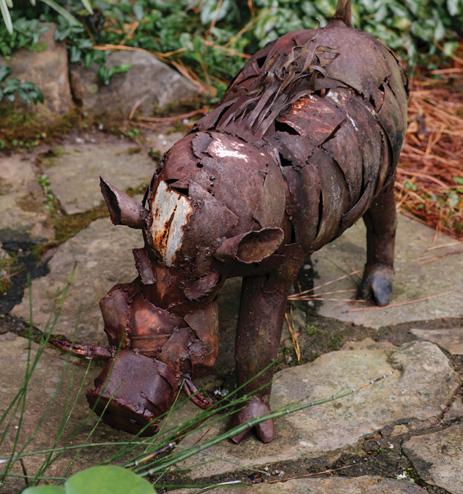
Berry Hayter encourages people to spend more time outside, to create small daily habits that connect indoor and outdoor living. “Take your coffee outside first thing in the morning when it's not so hot, then water a few pots on your deck!" she says.
favorites like snapdragons, nasturtiums and pansies. “These plants link me to my ancestors on my mother’s side, who were farmers in Kent,” she says.
Such harmonious blending of styles and specimens wouldn’t be easy for most gardeners to achieve. But Berry has a degree in landscape architecture technology and works as a residential garden designer. She used her expertise to add strategic hardscaping to the backyard. The winding, mossy stone wall gives a natural flow to the space, anchored at one end by an asymmetrical boulder and at the other by the water feature and sculpture.
In the front yard, Berry has converted a strip of lawn into a buzzing pollinator garden. By layering newspaper and compost over the grass and planting a variety of flowering perennials, the space is now a haven for bees and butterflies. The space is densely planted with species that bloom at different times and staggered heights, like hibiscus, rudbeckia, pineapple lily, bee balm and Joe Pye weed.
An unexpected focal point in her backyard plot of earth is a prized specimen plant, the voodoo lily, which Berry received at a Master Gardeners’ plant swap. Also called corpse flower, the voodoo lily is a rare bloomer, opening once every seven to 10 years for a brief 24- to 36-hour window — with a notorious aroma of rotting meat. Berry’s original plant first bloomed in March of 2021, and there is a new propagation taking root in the front yard “for all the neighbors to enjoy,” she laughs.
While Berry’s work in the garden is never done, it lends purpose and satisfaction to her days. Rather than gardening in long stretches, Berry has found that a little weeding and deadheading each day is the best way to tend a thriving space. “Even when I’m taking out the trash, I pull a few weeds,” she says.
Berry also takes time to observe her garden and record its changes. “I keep a notebook — I write down the date that I plant things, and will note the weather, the frost, when I cut things back. Over years, you get to understand how
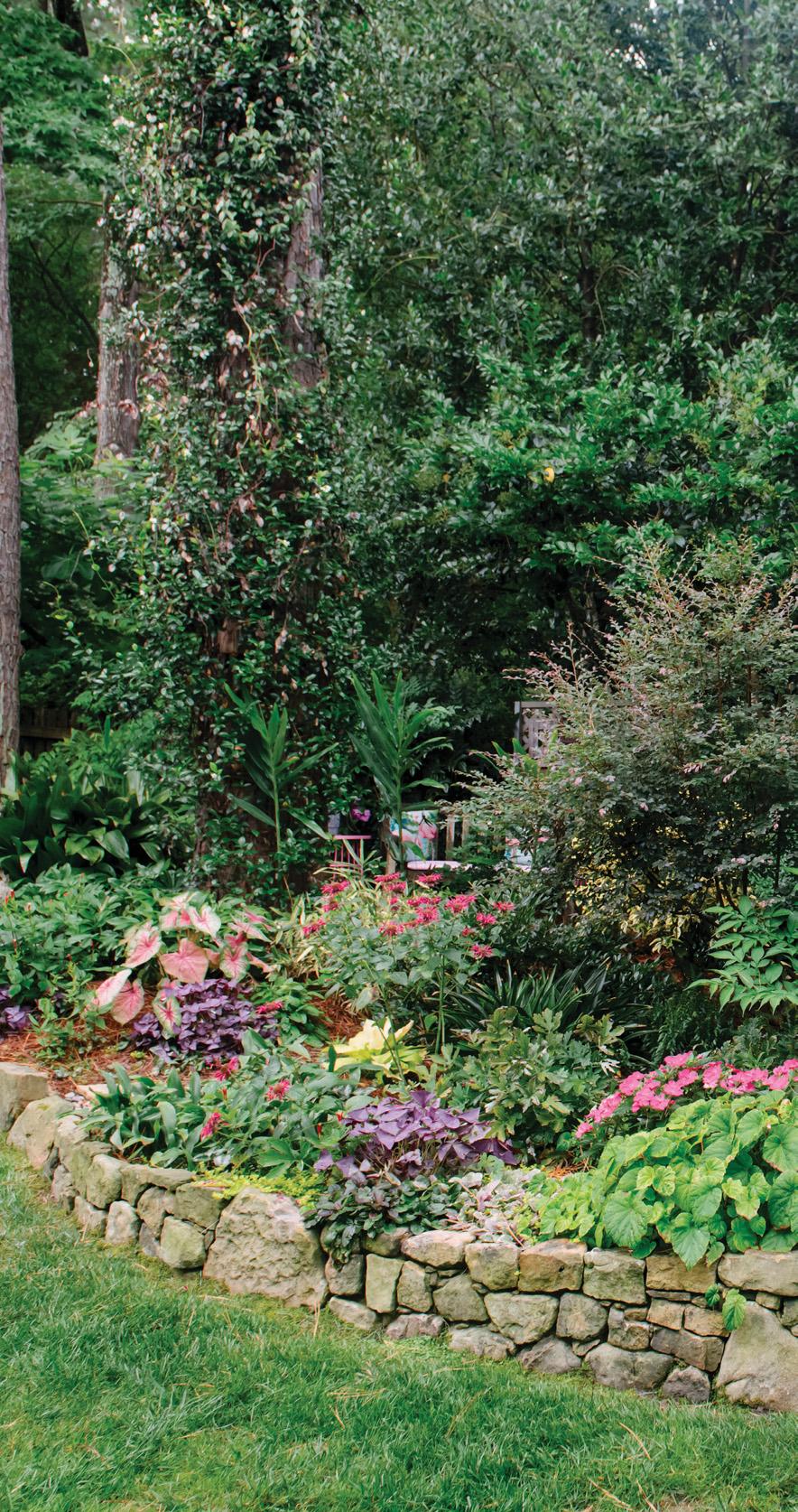



In the Hayters’ garden, plants with staggered bloom times, structural evergreens and early spring bulbs stretch botanical beauty throughout the year, helping ensure that no canvas is ever blank.





the seasons change, how the sunlight changes,” she says. When the Hayters first moved in, the soil was a depleted, rocky clay. Now, Berry adds compost to nourish the soil and she feeds plants with worm tea from her vermiculture bin. Her soil is rich, workable, and well-draining. “But it was not a quick process,” Berry says
She clusters shade-loving plants in the darker corner of the yard, opting for species with rich colors and patterns, like variegated Solomon’s seal, pink impatiens, bear’s breeches and Japanese-painted fern. In sunny and warm pockets, Berry layers heat-loving species like crocosmia, coleus and four o’clocks at varied heights, maximizing color and texture in each bed. “I sit on the patio while we’re drinking wine and think OK, there’s a little space there, and I want a bit of yellow to go with that purple,” Berry says. “There’s a lot of time spent looking at different angles, thinking about what I want.”
In September of 2019, the Hayters hosted their daughter’s wedding in their backyard. “It was something I had secretly hoped for, but didn’t want to suggest or push,” she says. But when her daughter asked, Berry was thrilled to open up the garden for the 50-guest affair. Berry arranged the flowers, delighted that her daughter wanted bold, bright colors to complement her garden’s signature style.
“It was a dream come true, but it was a challenge to keep everything looking good over the summer,” she says. “I asked her if she wanted it in the spring, with white annuals, and she said no — she wanted me to keep to the generally loud color scheme that I usually have.” Her daughter now lives in New York, where she tends a small garden that her parents helped install.
This August, Berry and Dick will celebrate 40 years of marriage and 25 years of working in their garden. “This garden contains so many memories and has matured over the years along with us,” says Berry. “It’s all a work in progress, but it is a very satisfying feeling to watch it all grow and change.”
When it comes to landing one of the biggest fish in the world off the North Carolina coast, it takes a skilled captain, an angler with endurance — and sometimes, straight luck.
The Big Rock competition started small. In the spring of 1957, a group of Morehead City fishing enthusiasts partnered with local businesses to gather a cash prize for whoever could catch a blue marlin off the Crystal Coast. Up to that point, the billfish had only been rumored in the waters.
It took months, but by mid-September, Raleigh angler Jimmy Croy, fishing aboard the Mary Z with Captain K.W. “Bill’’ Olsen, caught a 143-pound blue marlin. They radioed back to shore on their way to the harbor, and when they arrived, a raucous crowd had gathered.
This fishing contest became an annual tradition; over the years, the rules became formalized and the prizes grew. In 1972, the competition was renamed Big Rock, after a prime spot in the gulf stream for finding blue marlin. Now in its 65th year, it enlists about 200 boats and nearly 1,600 competitors — and the purse is in the millions. For many in Raleigh and along the coast, it’s a much-anticipated tradition.
“When I was a kid, my mother would deliver me to the tournament, and I would watch the guys bring the fish in,” says Tommy Bennett, a Morehead City native, longtime Big Rock board member and past president of the organization. “Fighting a blue marlin was always a dream.”
The competition attracts both full-time anglers and avid amateur fishermen. For some, Big Rock is one stop on a circuit of fishing contests from Bermuda up the East Coast. “All the competitors are there, and it may be the first time they’ve seen each other in eight or nine months — they look forward to it,” says Bennett. Boat captain Neil Sykes agrees: “The competitions are really fun — aside from the possibility to win money, you get to see friends you don’t get to see a lot.”
The big prize is for the heaviest blue marlin. The competition lasts six days; each boat fishes four of them. Every day, the
leaderboard changes, so boats know not to bring in a 400-pound marlin if, say, third place already weighs in at 500 pounds. The catch: you can’t weigh the fish until you get to shore, which adds to the drama. (You can measure them, and experienced fishermen can ballpark it on deck.). Ninety-five percent of the fish that are caught are released. Sykes, who lives in Virginia Beach, is the captain of the Merceneria, a 72-foot Viking whose owner, Chad Ballard, won the grand prize last year. Ballard pulled in the 572.6-pound blue marlin on the first day. “It made for a long week!” says Sykes, who says he’s been fishing these waters all his life. “We look for eddies where water splits off from the gulf stream, where temperature breaks hold fish.” The captains talk amongst themselves about where people were catching the day before, sharing tips — or not. “Everybody’s friends, but sometimes people get a little more tight-lipped,” Sykes says.
Raleigh resident David Pirrung has fished the Big Rock for decades alongside his friend JJ Johnson and their captain, Jay Watson, on the Widespread, a 51-foot Crown Marine. “We all like to hang out together, we’re strategic about the fishing, but we like to have fun,” he says. He credits Watson for knowing where to fish: “He makes the decisions!”
As Pirrung’s three sons have gotten older, they’ve joined the team — and made some amazing catches. “Each of my kids has killed a fish in the last three years,” Pirrung says. In fact, it was Pirrung’s son Cole who caught the winning fish in 2021, a blue marlin that weighed in at 656.5 pounds.
The way the Widespread team does it, once a fish hits, one angler gets the rod. “If anybody else touches the pole before the mate gets the leader, it’s not a clean catch,” Pirrung says. It took Cole four hours to reel in that winning marlin. “His hands were totally destroyed, but we knew it was a winner,” says Pirrung. “I called my wife in Raleigh and said, You probably need to come down, we’re going to be partying.”
The Mercenaria heads east along the cut between Big Rock Landing and Sugarloaf Island after winning the 64th annual Big Rock Blue Marlin Tournament in Morehead City.


Big Rock is a sport fishing competition with humble roots and surprising fervor


 by
by
 AYN-MONIQUE KLAHRE photography by DYLAN RAY
AYN-MONIQUE KLAHRE photography by DYLAN RAY
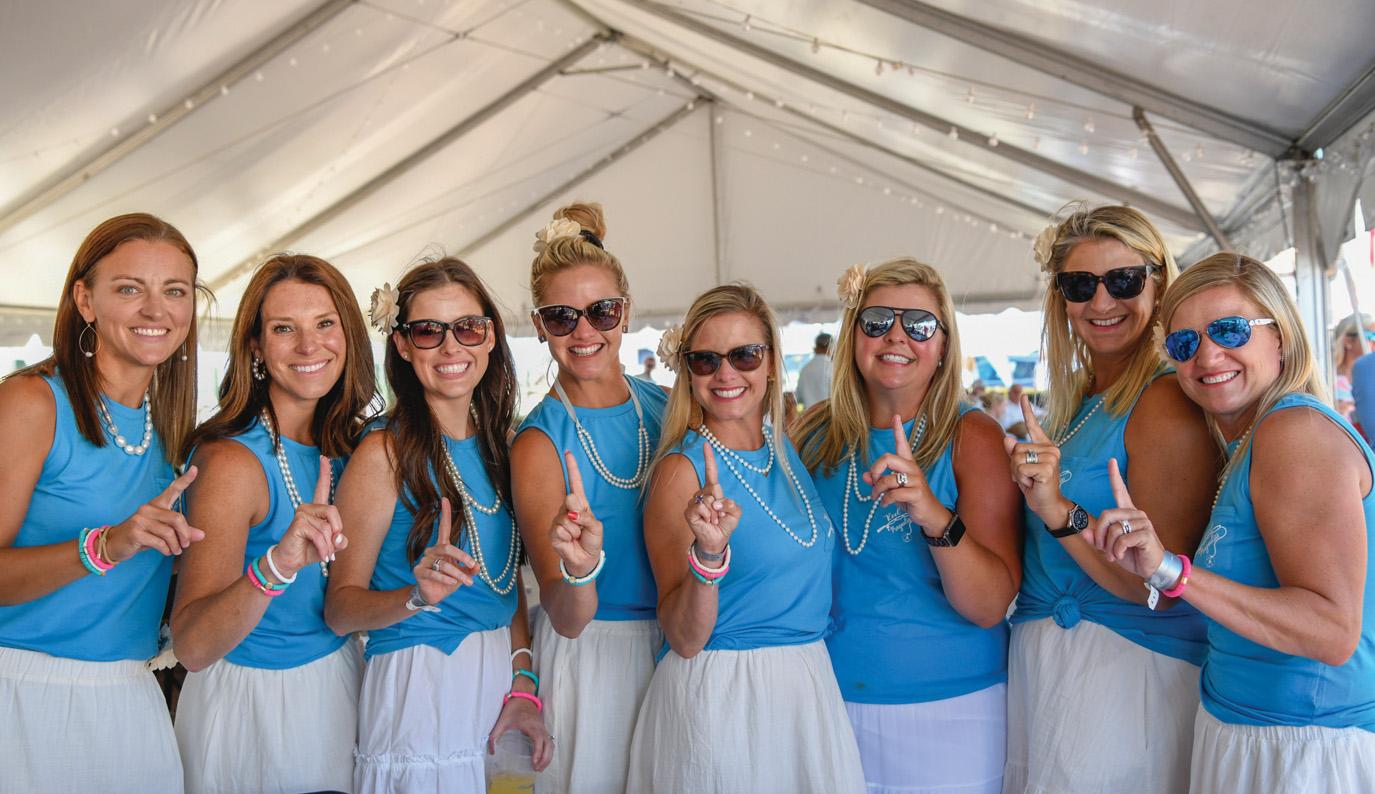
Fish have to weigh in by midnight. For the Widespread, it was a race to the finish. The fire department sent trucks to light the dock, where an enthusiastic crowd had gathered. “When we pulled into the dock, there were people all over,” says Pirrung. “Hundreds of people behind the docks staring at you, microphones and cameras in your face…. it’s a lot!” says Sykes.
(Unfortunately for Luke, Cole’s brother, that fish knocked his 479.2-pound marlin out of third place. But along with their other brother Connor, who placed in 2019, the three young men are the only three brothers to have each boated and weighed a blue marlin at Big Rock. “Jay is top-notch. My family and I know very little about marlin fishing, we just know how to pick a good captain,” laughs Pirrung.)
Big Rock also includes a Lady Anglers competition for female fishermen, a Junior Anglers element and the Big Rock Hero program to pair active-duty military with fishing boats. Big Rock hosts parties and other entertainment during the competition, and the boats themselves are an attraction, from large center console boats
to sport fishing boats to small ones with outboard motors.
Sometimes, there are celebrities. “The first year Michael Jordan came here, he weighed in a blue marlin. He’s been back to the scales since, and there’s a crowd like I’ve never seen,” says Bennett. “You don’t need a ticket, you just show up and it feels like a big family reunion, people fill out the restaurants and go to the beach, and when they weigh the fish, folks cheer like they’re at a football game.”
Further from shore, folks can follow along on social media or the internet. “For about 10 days of the year, the entire world of sport fishing is focused on North Carolina. People are on their computers listening to Randy Ramsey give the blow-by-blow playby-play of the tournament,” says Bennett. “You can watch your buddy weigh in from your computer in Raleigh.”
The organization has also made strides in conservation, creating weight limits to release fish that won’t make the grade to reduce the number of blue marlin brought to shore. “They only pay for first, second and third, so you’d feel like an idiot if your fish
were 50 to 100 points under,” says Pirrung. “Nobody wants to kill a blue marlin that’s not in the money.”
They’ve also made charitable giving a huge component of the competition, donating $7.5 million to area charities as of 2022. “It’s a first-class operation; they do a lot of good things for Eastern North Carolina,” says Pirrung. Bennett’s particularly proud of how the competition has invested in infrastructure like helping build the Big Rock Stadium in Morehead City (where, appropriately, the Morehead City Marlins play, along with youth leagues and college tournaments) and buying land for the Crystal Coast Hospice House.
Big Rock is more than a fishing competition: it’s a community booster and a family event. As Pirrung’s sons graduate college and start their careers, he expects they won’t be able to take a week off for the tournament any more. “But JJ’s got kids that can start cranking soon — so we’ll keep going out,” he says. “The fishing is great, the catching is a bonus.”
Especially if you can get back to Morehead City in time to weigh in.
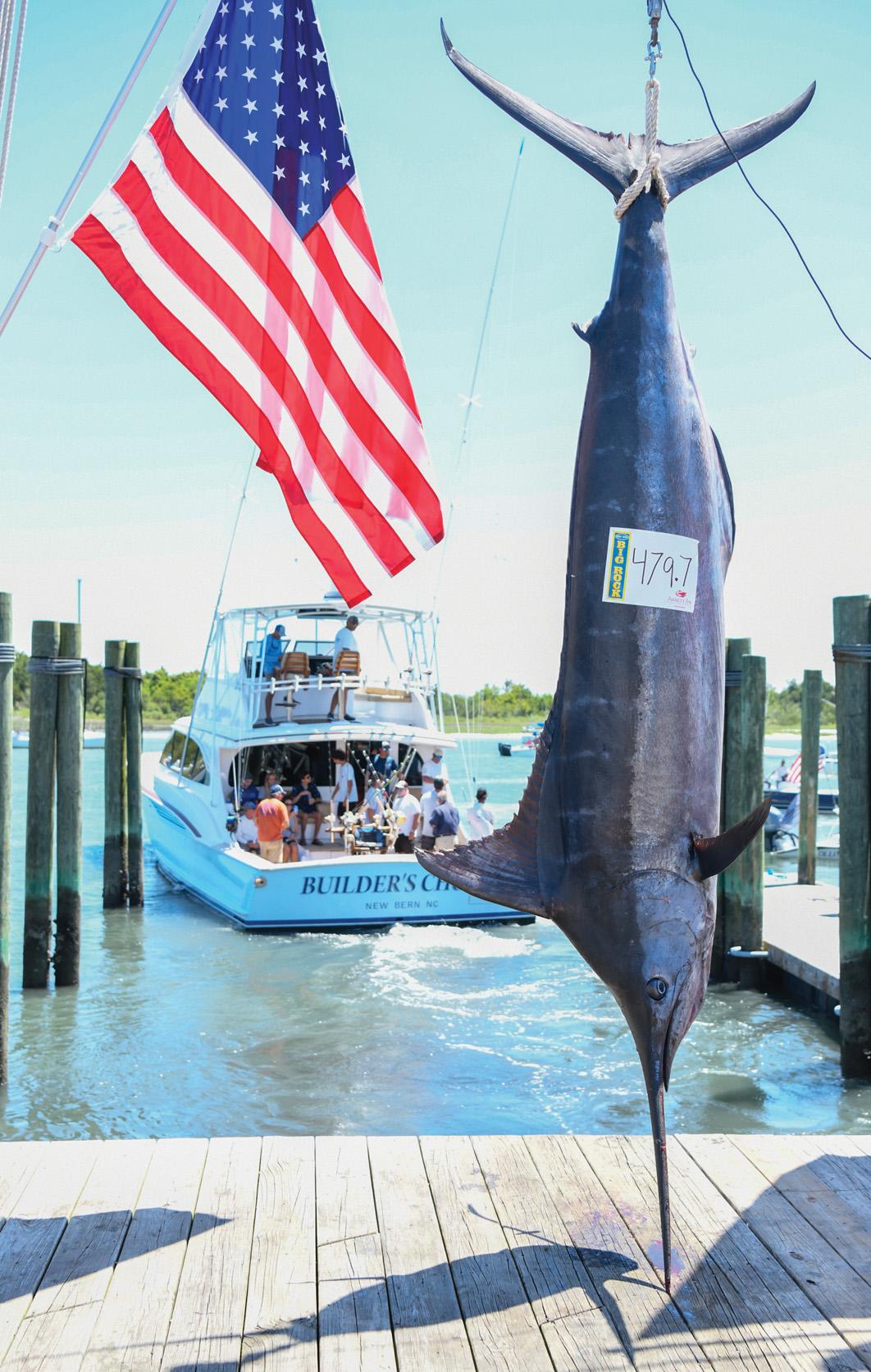
Opposite page: The women from the Can Do Too team, which won the 25th annual Keli Wagner Lady Angler Tournament in 2022. This page: A blue marlin getting weighed.
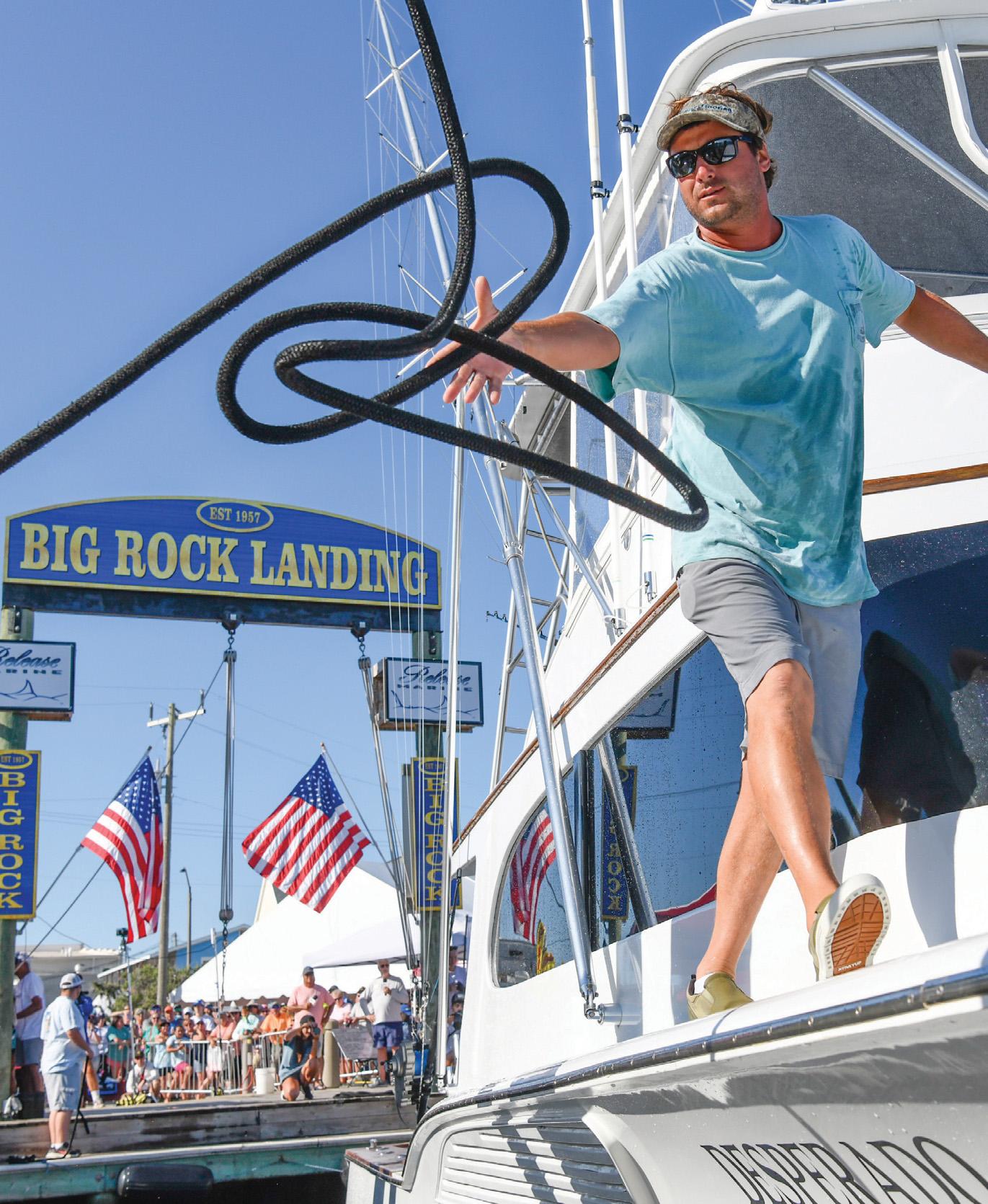

THE HAUL On shore, there’s plenty of action and opportunity to follow along. In addition to the big prize for blue marlin, there are other competitions: for the first billfish of the day; for the boat that catches and releases the most billfish in the week; and for the largest dolphin, tuna or wahoo.


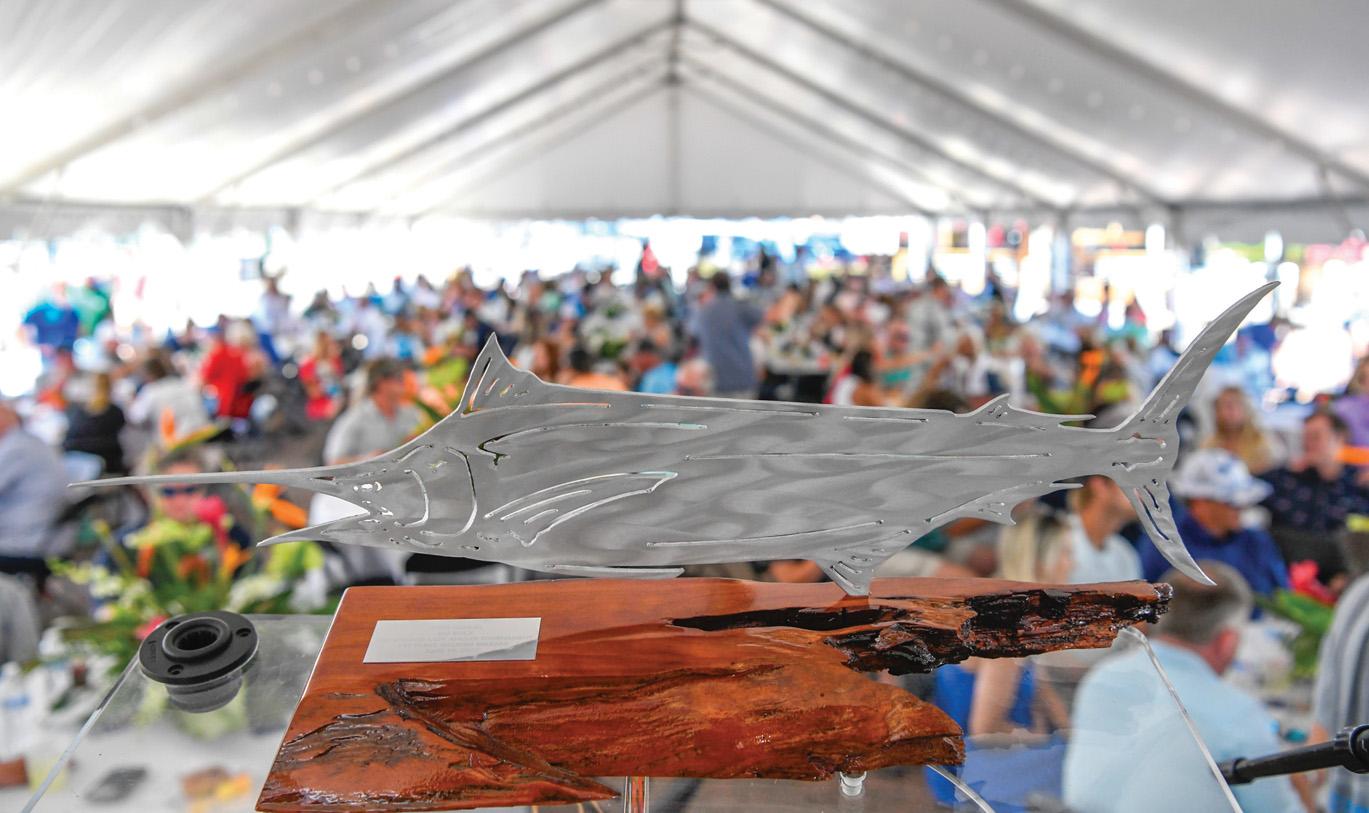

Opposite page, top: Big Rock weighmaster George Lott guides the tail of a 572.6 pound blue marlin from the Mercenaria on the first day of fishing during the 2022 Big Rock tournament. Bottom left: The winners award. This page: Angler Crystal Johnston stands with her 131.2 pound yellowfin tuna, caught aboard the Desperado.


Bob Rankin blends talent and teaching to uplift Raleigh’s creative community
Down an unassuming stone pathway on St. Mary’s Street, there’s a contemporary gray cement building tucked among trees and foliage. From one corner, a red wall cuts at an angle, accented with a giant, lime-green “R.” A lush, Japanese-style garden flanks the entrance to the studio featuring a koi pond, plants of many colors and two gray-and-white Persian cats waiting for visitors.
This is the home studio of artist Bob Rankin (he likes to call it his “houdio”). The front door opens up to a vast and rambling workspace, the ceilings punctuated by skylights, with a trove of visual treasures from an artistic career spanning more than 50 years.
Bins are stacked with tubes of acrylic paint and other supplies. House plants are scattered throughout, including a potted orange tree teeming with tiny fruits that Rankin makes into jam. And paintings of all sizes and subject matter hang neatly on the walls, with blank canvases stacked along the floor.
“I’m probably best known for these large-scale abstract works,” Rankin says, gesturing to several massive, colorful pieces on the wall.
Rankin’s portfolio of mostly acrylic paintings contains soothing and subtle responses to nature and international travels, often in imaginative interplays of color. Rankin has exhibited his work across the city, including in the Little Art Gallery and the Mahler Gallery, and his work has been shown throughout the United States. Some personal highlights include appearing at the 1982 World’s Fair in Knoxville and internationally through an artist exchange program in Marrakesh, Morocco.
A lifelong Raleigh resident, Rankin grew up in the Five Points neighborhood and started honing his craft at Myrtle Underwood School. His third-grade teacher, Rose Melvin, inspired him to

explore his creative talents when Rankin won the class’s Halloween art competition. In return, he received the privilege of decorating a bulletin board while the other children did schoolwork. “It’s amazing how little gestures like that can make such a huge impact,” he says. (Rankin remained friends with Melvin until she passed away in 2013.)
As a student at Broughton High School, from which Rankin graduated in 1966, he drew and painted pieces that remain framed in his studio today. Rankin’s art teacher there, Alice Ehrlich, had a particular influence. “She encouraged originality and creativity in her students,” says Rankin. He remembers
field trips with Ehrlich and his classmates, like visiting a home that held what was believed to be the only original Picasso in Raleigh at the time. “She was enthusiastic in a way that was absolutely contagious,” he says.
But Rankin is known just as much for being an accomplished artist as he is for his ardent work as a teacher, philanthropist, mentor and community organizer.
After finishing the art education program at East Carolina University, he returned to Raleigh and began teaching art, first at Ligon Middle School, then at Sanderson, Garner and Millbrook High Schools. “I love the honesty of high school students; they don’t hold anything back

“He’s so generous and never asks for anything in return... And every time I look at his artwork it’s just so colorful and vibrant and beautiful.”
— Bearta Alchacar


 Clockwise from top: A peak inside Rankin’s studio, Red Emergence, and High Energy.
Clockwise from top: A peak inside Rankin’s studio, Red Emergence, and High Energy.

and tell it like it is,” he says.
Rankin retired from teaching public school in 2000, but keeps up with many of the students he mentored and encouraged to pursue art-driven lives and careers. “There is so much talent in the area and I was able to tap into that as a teacher,” he says. In a recent performance, the Raleigh-raised writer and artist David Sedaris recognized Rankin for always making students feel special. “It really cemented the idea of how important teaching is,” Rankin says.
In the late 1970s, while working as an art teacher, Rankin had an idea to create an artist showcase and festival in The Village District (then known as Cameron Village). “I walked into the office with lots of exuberance and told them, I have an
idea for an art show,” Rankin remembers. Management agreed to publicize and host the event if Rankin would be the organizer. Art in the Village was born.
“It turned out to be a very successful show — so much so that it outgrew the Village,” says Rankin. He then reimagined the event to be hosted at Pullen Park as “Pullen Arts,” with conceptual art, dance and music throughout the park. “For three or four years, the weather was perfect and people came out in droves,” he says. “Cars were lined up all the way to Channel Five to get in.”
The event was rebranded again, in 1980, as “Artsplosure” in Pullen Park. Then the City of Raleigh became involved in organizing the event, which was moved to its current home on

Fayetteville Street.
By the mid-1980s, Artsplosure became too big for Rankin to organize as a volunteer, so he passed the baton to staff and continued his support as a board member.
Artsplosure has grown exponentially in the decades since, far beyond what Rankin describes as its “very grassroots” early years.
Rankin gives much of the credit to his friend and colleague Michael Lowder, who served as executive director for over 25 years before his retirement last year. As Raleigh grew, “we put an emphasis on raising brand awareness and bringing in even more artists,” says Lowder.
These days, Artsplosure brings tens of thousands of patrons to downtown
Raleigh each May and continues to expand its programming and connection-making. The organization has contributed to and co-hosted an impressive lineup of events, including the inaugural IBMA Bluegrass Live! event, the African American Cultural Festival, First Night Raleigh and Live it Up!, Hillsborough Street’s annual event. In recent years, Artsplosure worked with Dreamville Music Festival to bring local arts and crafts vendors to the internationally attended event.
In addition to his continued work with Artsplosure, “I’ve been on most every major board that has anything to do with art in Raleigh,” he laughs, including the Visual Arts Exchange, Raleigh Art People, Artspace and the Raleigh Arts Commission.
One of Rankin’s greatest community achievements is helping to launch the Raleigh Public Art and Design Board, the city’s advisory body that reviews and manages public art projects and programs. In 2009, Rankin was a member of the Raleigh Arts Commission. He teamed up with its chair, Laura Raynor, to establish a program within the city government focused on public art projects.
“We developed guidelines and a public art policy for the city of Raleigh,” Raynor says. “It was a privilege to be involved in the building up of the arts program because it’s really a shining star in our city.”
These days, Rankin continues to be involved in many arts organizations — and is constantly making more art. “I have a little bit of talent, but I can outwork anyone,” he says. “The busier I am, the better I am.”
Lowder agrees: “He is so prolific and just creates all the time. He continues to be inspired by everyday life.”
While Raleigh is home base, many of Rankin’s creations are inspired by his travels. A teaching gig in Italy, for example, yielded a series of landscapes based on the surrounding countryside. Recent travels to Iceland inspired a collection reflecting the country’s fantastically varied geography. “I love the power and sensuality of red,” he says of a


piece capturing his impression of a stream of lava he witnessed at a volcano.
Rankin often donates his work to organizations like The Caring Community, The Walk for Hope and the Raleigh International Festival. “He’s so generous and never asks for anything in return,” says Bearta Alchacar, the organizer of global programming like the Raleigh International Festival, noting that he’s donated art for the event for more than 30 years. “And every time I look at his artwork it’s just so colorful and vibrant and beautiful.”
Rankin has received the East Carolina University Leo Jenkins Award and the Raleigh Medal of Arts. He’s also been recognized by a plethora of organizations as Best Artist in the Triangle and is an inductee into the Raleigh Hall of Fame and the Wake County Public School System Hall of Fame, among many others. Despite the accolades and international inspiration, Rankin remains humble, committed to arts advocacy, and rooted in Raleigh. “This city has been awfully good to me, and I want to share what I’ve been given,” he says.

WALTER’s roundup of gatherings, celebrations, fundraisers and more around Raleigh.
86 At the Table with Susan Gravely
89 NC Symphony Education Concert 90 All Booked Up 92 Discovery Ball 93 Best of NC 2023 93 SECU/ACCOSCA Event 94 Maintain Your Brain Battle of the Bands
To have your event considered for The Whirl, submit images and information at waltermagazine.com/submit-photos
On April 5, WALTER hosted At the Table with Susan Gravely in honor of her new book, Italy on a Plate: Travels, Memories, Menus. Along with her sister and mother, Gravely started VIETRI 40 years ago after a trip to the coast of Italy. Now the largest American importer of Italian ceramics, VIETRI and Gravely celebrate togetherness over incredible food on a beautifully set table.
Twinkle lights and a lush lounge area set the scene at Transfer Co. Food Hall, where the wine and beer were flowing. Andrew Hannon of Alimentari at Left Bank prepared an Italian feast to fit the theme.
After mingling with guests, Gravely took to the microphone to speak about her book, which captures the joy of good food through essays and recipes. After the talk, the author Frances Mayes hosted a Q&A session with her dear friend.
Thank you to our presenting sponsor, Fink’s Jewelers, and supporting sponsors, VIETRI and Green Front Furniture, for making this event possible. Thank you also to our event partners Alimentari, Westgate Wine, Wye Hill Brewing, The Country Bookshop and Attended Events for creating a lovely atmosphere.





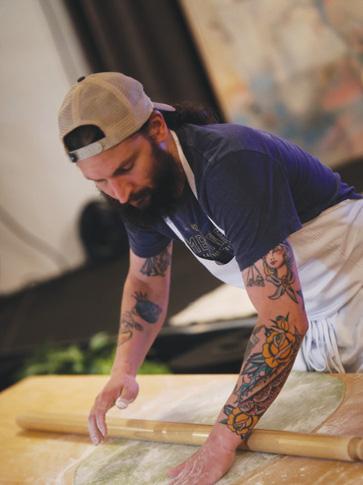











NC SYMPHONY EDUCATION CONCERT
The North Carolina Symphony’s education concerts give Wake County 4th graders an introduction to a variety of instruments and music. This event honored Freddie Lee Heath for his role in music education for WCPSS over the past 30 years.

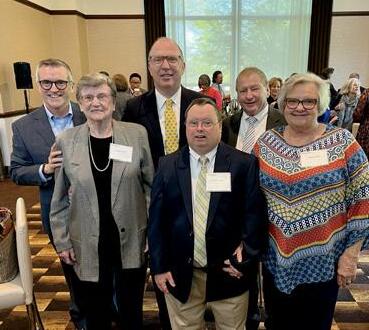
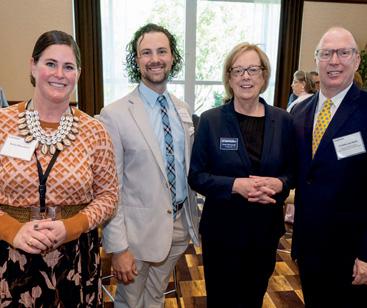





Who brings your fairytale wedding to life? We Do.
Nestled in the heart of Southern Pines, our historic Georgian Manor Boyd House and acres of curated gardens and grounds provide an unparalleled backdrop to gracefully meet everyone’s dream.
For over 40 years, this fairytale estate has captured the hearts of couples across the state and country in search of the perfect spot to begin their happily ever afters. Whether you’re in search of a venue to house an intimate ceremony, or a picturesque spot to accommodate your larger-than-life guest list, Weymouth Center for the Arts & Humanities checks all the boxes.
Couples can choose to exchange vows within the hallowed walls of the historic Boyd House, or opt for an alfresco soirée among the ponds, fountains, and blooms of the scenic gardens.
Who Brings the Fairy Tale to Life When You Say, “I Do”? We Do. Let us help you write your next chapter today.
555 E. Connecticut Avenue • Southern Pines, NC 910-692-6261 • weymouthcenter.org weddings@weymouthcenter.org

ALL BOOKED UP
On April 29 the Durham Library Foundation hosted All Booked Up, an after-hours party celebrating the library. Occurring alongside Durham County Library’s Third Annual Library Fest: The Storytelling Edition, the event featured behind the scenes access, library tours, live demonstrations and festive food and drink.
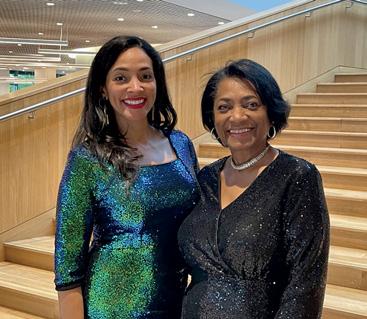

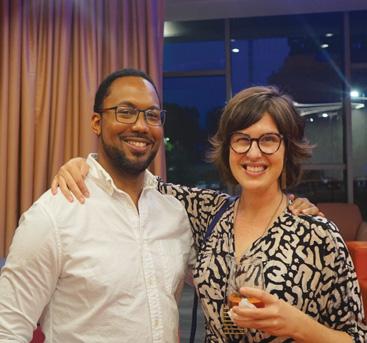
Our signature innovation event returns featuring inspiring workshops and moving talks by local female leaders.
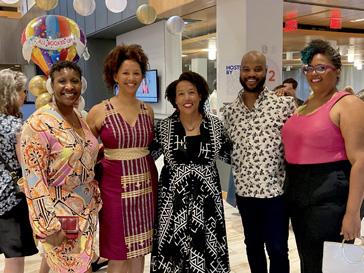





Friday September 16
Join us at the Umstead Hotel & Spa for our annual innovation summit celebrating female entrepreneurship and leadership.











DISCOVERY BALL


On February 24, the American Cancer Society of North Carolina hosted its inaugural North Carolina Discovery Ball. The event raised $250,000 to improve the lives of people with cancer and their families through advocacy, research and patient support. Through these donations, they are fighting to end cancer as we know it, for everyone.










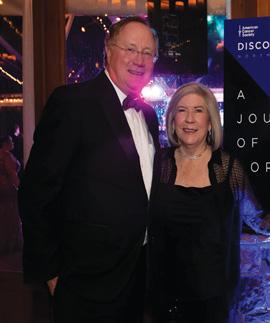
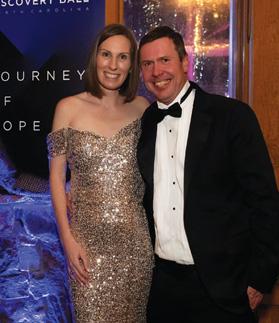
On March 19, Gallery C hosted its annual Best of North Carolina Exhibit, featuring North Carolinian art from the 19th and 20th century. Guests enjoyed beverages and snacks, as well as a chance to meet several artists.


Kay Crowder, Reid Jenkins, Kitty Shanahan
The State Employees’ Credit Union recently hosted a delegation of credit union professionals from Africa to share insight into the cooperative’s structure and operations and its charitable arm, SECU Foundation. The visiting delegates were part of the North Carolina African Confederation of Co-operative Savings and Credit Associations (ACCOSCA) international Learn and Share Tour.
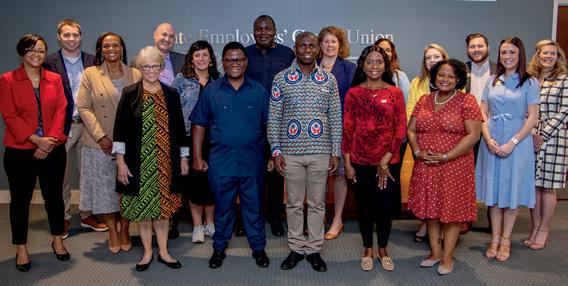












MAINTAIN YOUR BRAIN BATTLE OF THE BANDS
After a stroke took her grandfather’s ability to speak, NC State student Charlotte Fullbright became a voice for others facing neurological issues. The Maintain Your Brain Battle of the Bands increases awareness of mental health, stroke, dementia, traumatic brain injury and concussion. On April 15, more than 300 people gathered to raise money or the Triangle Aphasia Project.



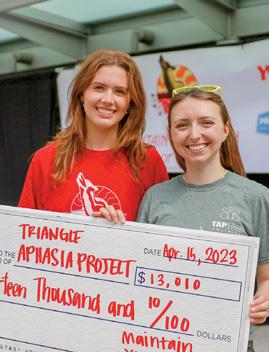


Take WALTER to go! There’s always something to discover on our website and social media. Here’s what’s been happening.
FOLLOW US @WALTERMAGAZINE





Emma Deal

Congrats to Cheetie Kumar and Paul Siler on the announcement of Ajja in Five Points opening soon! Can’t wait to eat there! @baxmiller
@justaregularhuman Very excited about this!!!!!!!
@lauraice01 Oh, boy! Close to home. Look forward to seeing y'all!
@helloyellow_studio So excited!



DISCOVERING URSULA PARROTT
NC State University professor Marsha Gordon talks about her new book on a mysterious and prolific writer of the early 20th century. As told to Addie Ladner

Got a chance to see *the* Stanley Cup in the office today, thanks to our friends at the @newsobserver Let’s get the Canes on there again!
@Susannaklingenberg Whoa! Bryan would be so jealous…

SNEAK PEEK: FOX LIQUOR BAR! Ashley Christensen’s underground bar has a new menu and hours, plus a makeover! We got first look. As told to Ayn-Monique Klahre

Sunday Open House from the Archives: Check out this charming Five Points home customized by Dixon Kirby, filled with both modern and classic pieces on a backdrop of calming whites.
@catherinecurrin
@cathnguyenphoto
@Punch_jones neat place.
@alleyinraleigh Beautiful home
Several years ago, when I was living in St. Petersburg, Florida, some friends gave me a gift in honor of my native city: a quirky little sculpture of Sir Walter Raleigh that they found at an art show. Sir Walter has watched over me from above my desk ever since. Recently, I decided to figure out who made him — and look a little deeper into his namesake’s smoking habits, too. Turns out, it’s quite fitting that folk artist Melissa Menzer uses a Sir Walter Raleigh tobacco tin for the body of this mixed media portrayal of him. History largely credits Sir Walter for introducing the New World “weed” to the folks back in England.
The explorer and adventurer is believed to have picked up an appreciation for tobacco when the leaf was brought back from the 1584 and 1585 expeditions he sponsored to Roanoke Island, years before the ill-fated 1587 Lost Colony settlement. According to the National Park Service, “Early on, the medicinal properties of tobacco were of great interest to Europe. Over a dozen books published around the middle of the sixteenth century mention tobacco as a cure for everything from pains in the joints to epilepsy to plague.”
Critics, however, were early to question this gift from the New World. In 1617, Dr. William Vaughn wrote: Tobacco, that outlandish weed/ It spends the brain, and spoiles the seede/ It dulls the spirite, it dims the sight/ It robs a woman of her right.
Despite the critics, Sir Walter is “credited with the introduction of pipe smoking in court circles,” even though “it was at first perceived as a strange and even alarming habit,” says the Park Service. Legend even has it that Sir Walter even offered the herb to his sovereign (and rumored lover) Elizabeth I.
We all know how science eventually ruled on tobacco’s impacts on health. But Raleighites can still appreciate Menzer’s nod to North Carolina’s early output and Sir Walter’s experimental mentality.
“Over a dozen books published around the middle of the sixteenth century mention tobacco as a cure for everything from pains in the joints to epilepsy to plague.”
The artist, who lives in Sanford, Florida, has made many renditions of our city’s namesake as well as other less famous characters. “I love the Sir Walter Raleigh tobacco because his face is on the tin,” she says. “I’m always looking for old tobacco tins. They make great bodies.”
Menzer’s proud of another Raleigh connection: Her son works for Advance Auto Parts. I find it ironic that a Florid-

ian made this ode to Raleigh — and that had I not lived in the Sunshine State, I might have never met him. When I face writer’s block, I sometimes look at my little officemate and lose myself examining his delicately sculpted accordion collar and bearded face. I ponder what he might think of the fabulous Tar Heel state he spearheaded. Then I shudder to think of that fine head landing in a basket on the other side of an axe outside the Tower of London.
Which makes me think of dead… then deadline… and I get my own head back to work.
















It’s feeling the pulse of the next level of cardiac care and wellness. It ’s seeing possibilities where others see roadblocks. Pioneering new minimally invasive procedures and robotic-assisted surgeries. Transforming theor y into curative strategies. Even more than that, however, it ’s passion, compassion, th its assion, co All joining experience, exper tise and technology. novation forces to create a special place where in saves lives. Visit us at ear ts. wakemed.org/h

Your heart. Your choice.

